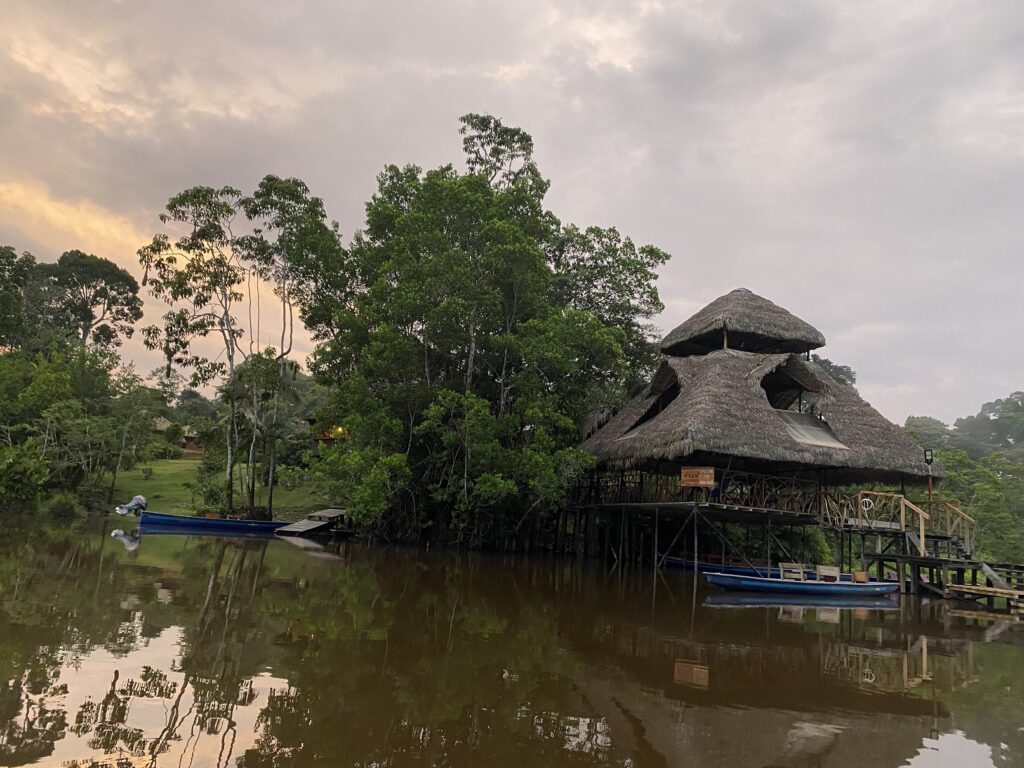
After about nine days of exploring Quito, Quilotoa Lake, and Banos in the Andes region of Ecuador, we headed east to the Ecuadorian Amazon. We had booked a five-day tour package with Sani Lodge in Yasuni National Park. Sani Lodge is 100% owned and operated by the Indigenous Kichwa community of Sani Isla.
Day 1
Our day started early as we left our hotel in Quito for a 9:30 am flight to Coca. It was a short 35-40 minute flight on Aeroregional.
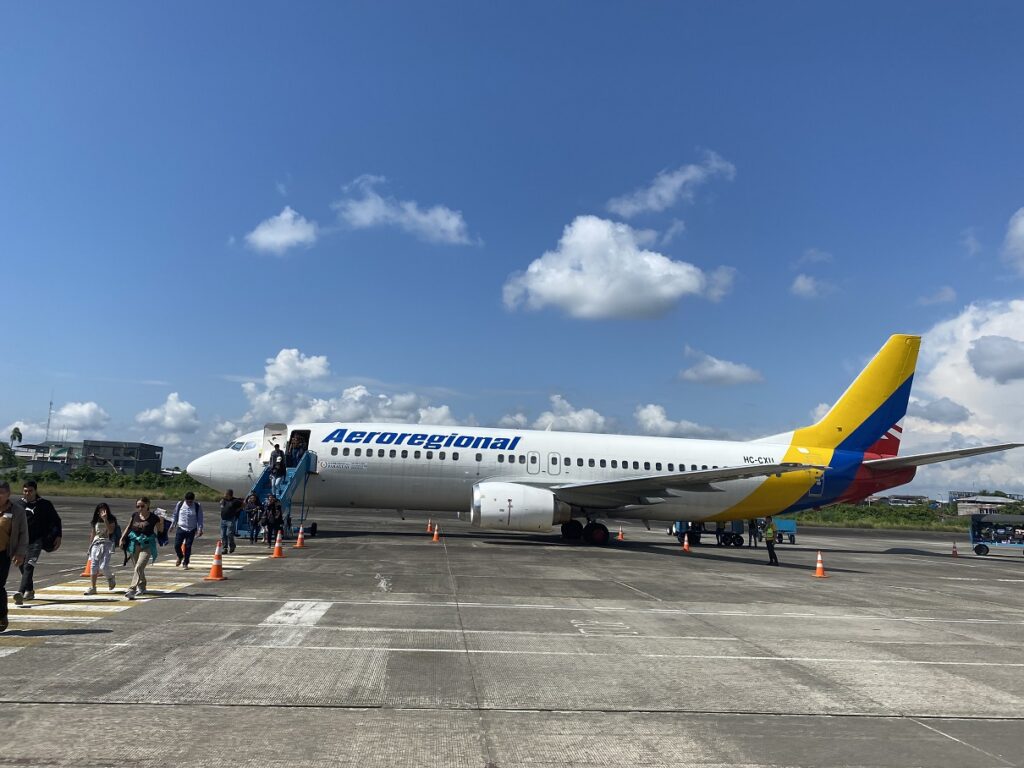
Raul, our naturalist guide for our trip, welcomed us at the airport, and we took a shuttle to the Napo River pier. There were six people in our group in total. Raul introduced us to the Sani Lodge team and then gave us an overview of the region. Hugo from the local community would be assisting Raul on all our trips.
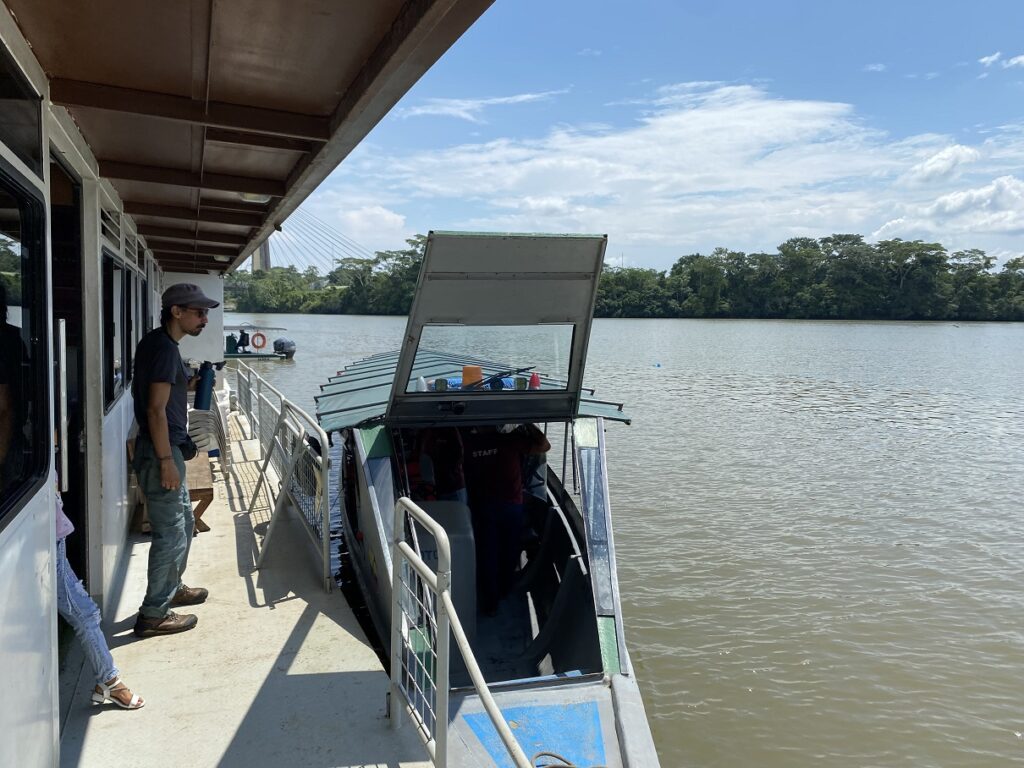
Around 11 am, we got on the motored canoe. In addition to the tour group, a few other people from the local communities along the Napo River also joined us.
The Napo River is the largest Ecuadorian tributary of the Amazon and is 1,075 km in length. Depending on the season and depth of the river, the canoe route through the river might change. The captain was always on the lookout for water patterns in the river and carefully navigated across the shallow sections.
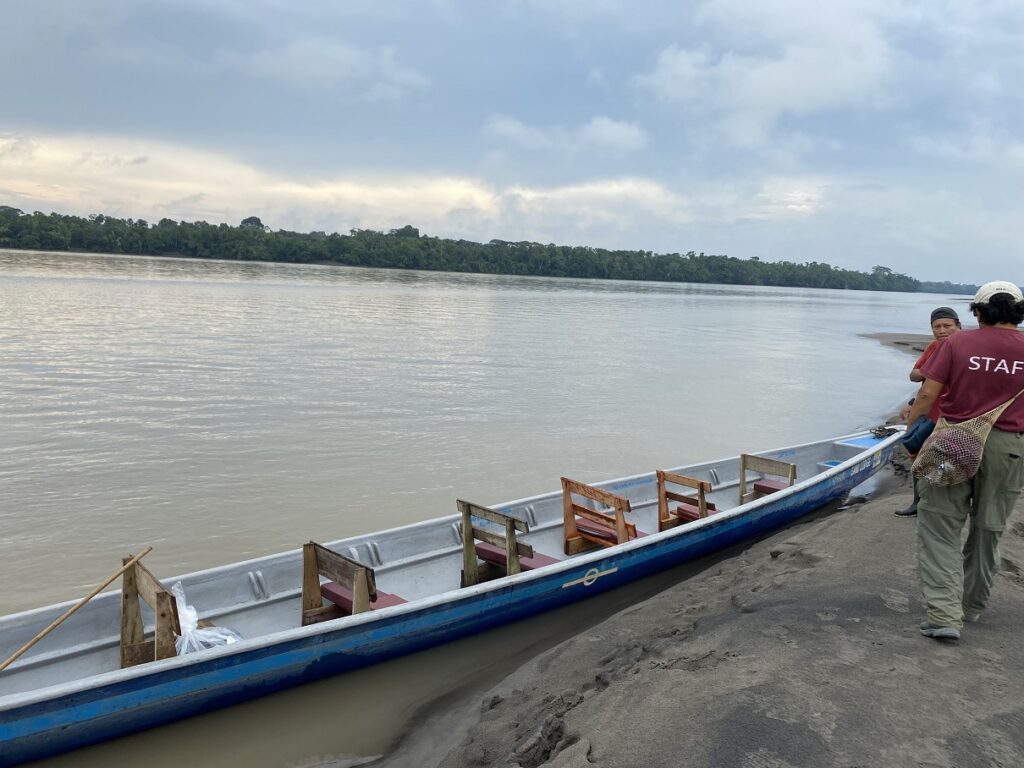
After about two hours on the canoe, we switched to a smaller motored canoe. There were about 10 of us, and we would now canoe through the flooded forest to the lodge.
The water was so shallow in some sections that the canoe would get stuck; the staff had to push against the sand with the paddles to find a better spot and continue. When the water level was high, they would put the motor back down and turn it on.
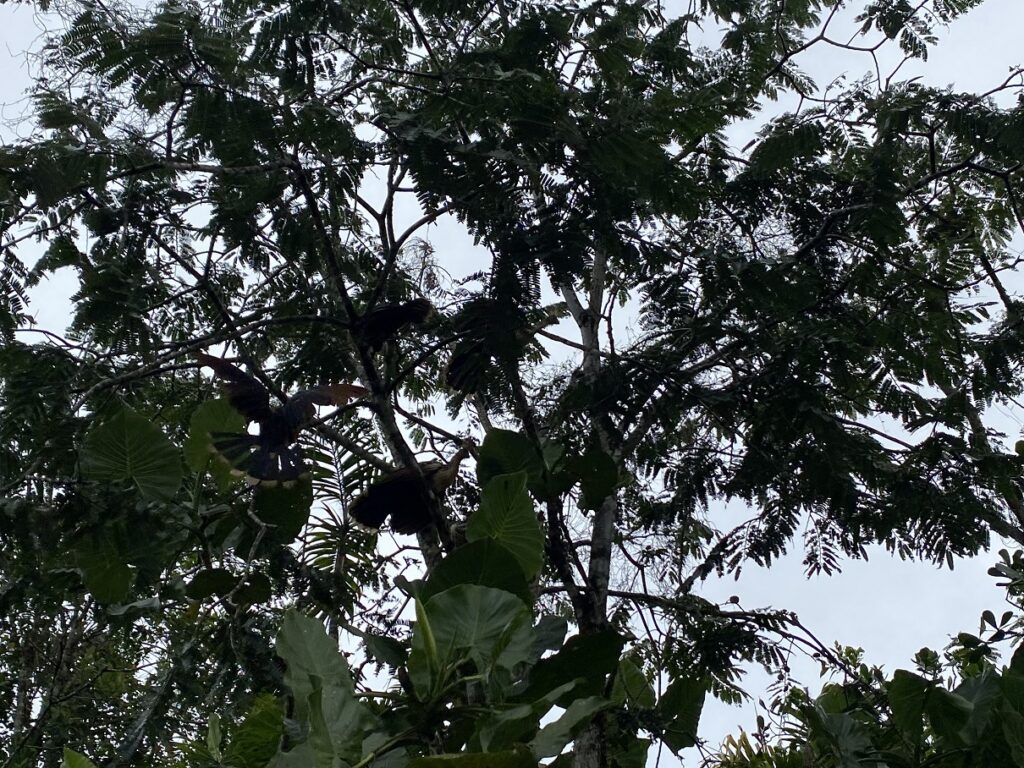
Raul was already pointing out some of the birds and monkeys, and we were admiring the diversity of this ecosystem. It was a special place.
Sani Lodge
After almost an hour and a half of canoeing through narrow sections of the flooded forest, we arrived at a black water lagoon – Challuacocha Lake and had the first glimpse of the lodge.
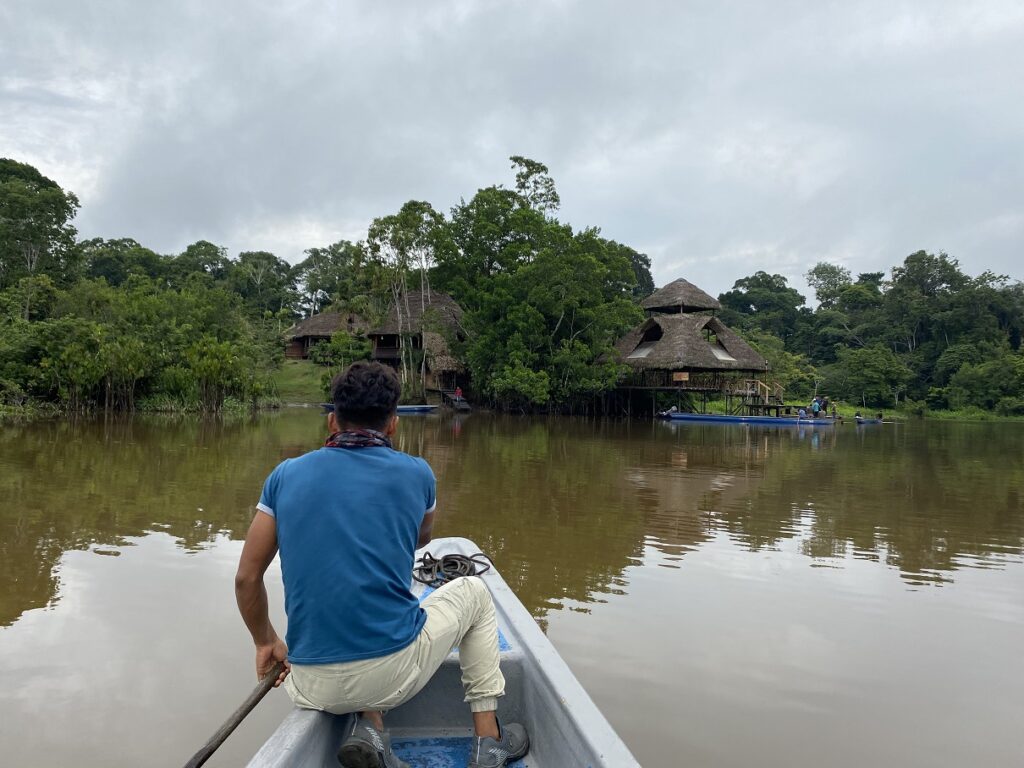
The Sani Lodge team was ready to welcome us, and after a short break, the manager gave us a quick overview of the lodge, different facilities and safety.

The lagoon is home to a caiman (South American alligator) named Mama Lucy, and occasionally, she makes herself comfortable on the lodge premises.

After some refreshments, we were guided to our cabins. Our cabin had a queen bed and a double bed. Kavya’s favourite spot was the hammock outside the cabin.
The three-story structure at the docking area was one of our favourite places to hang out as it had hammocks and was a great place to spot some birds.
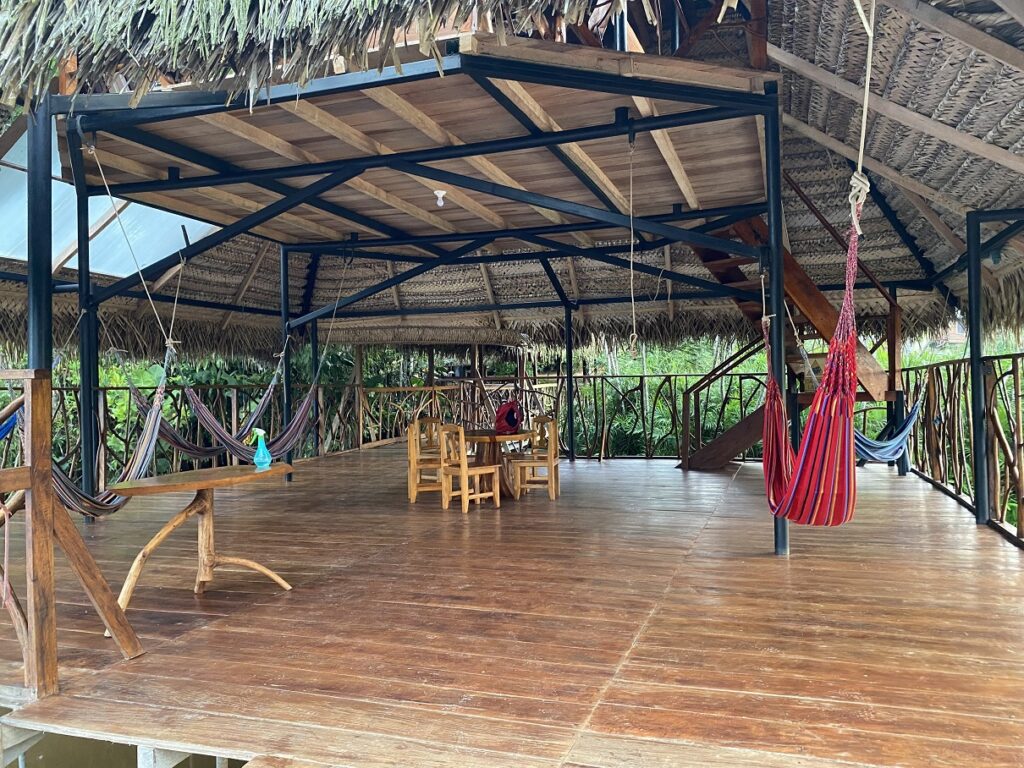
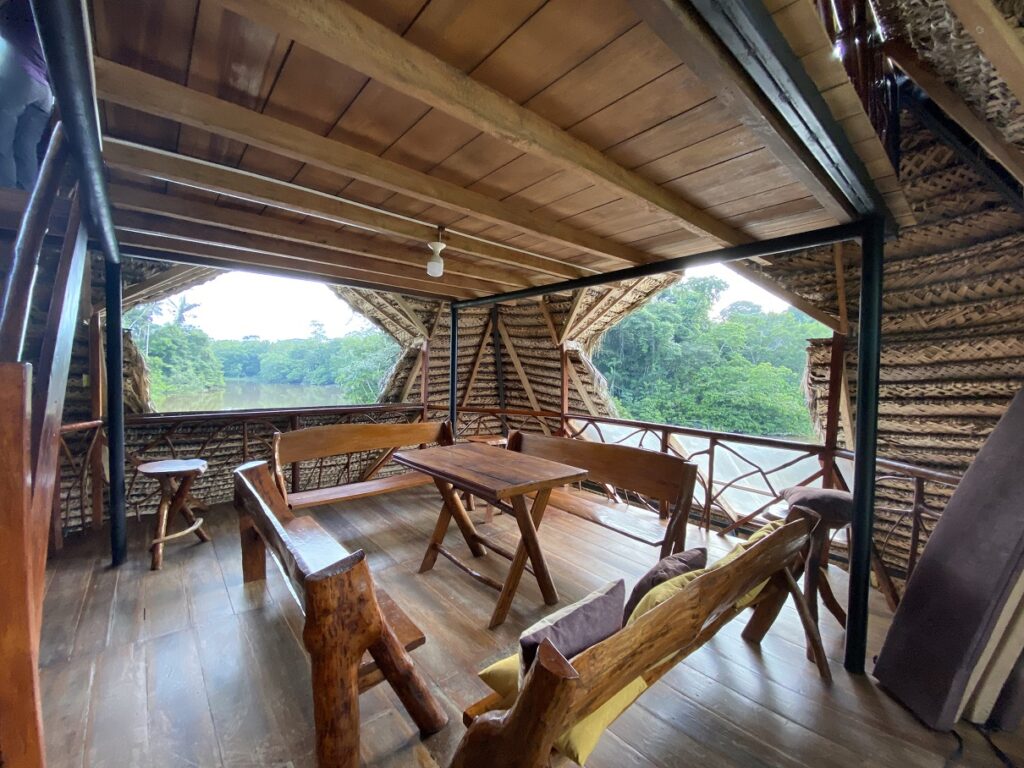
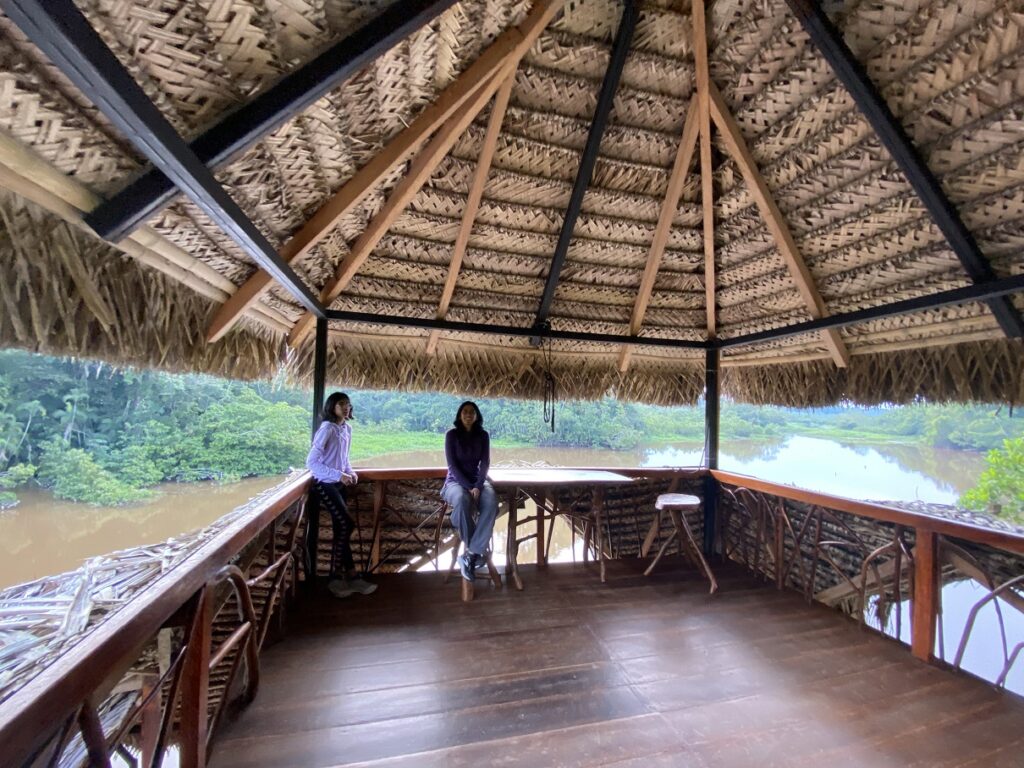
Later in the day, Raul took us out twice on a canoe trip. Once, around 5 pm, and then later at night, at 8 pm. We had a couple of binoculars in our canoe. Just for fun, I started making a list of all the birds and animals he was pointing out to us. Initially, I was making the list on my phone, but based on Raul’s suggestion, I started using the eBird app.
The Hoatzin (big turkey-like birds) were everywhere and easy to recognize. Kasturi’s favourite was the Oropendula, which would drop its body like a pendulum and make a distinct, sharp noise.
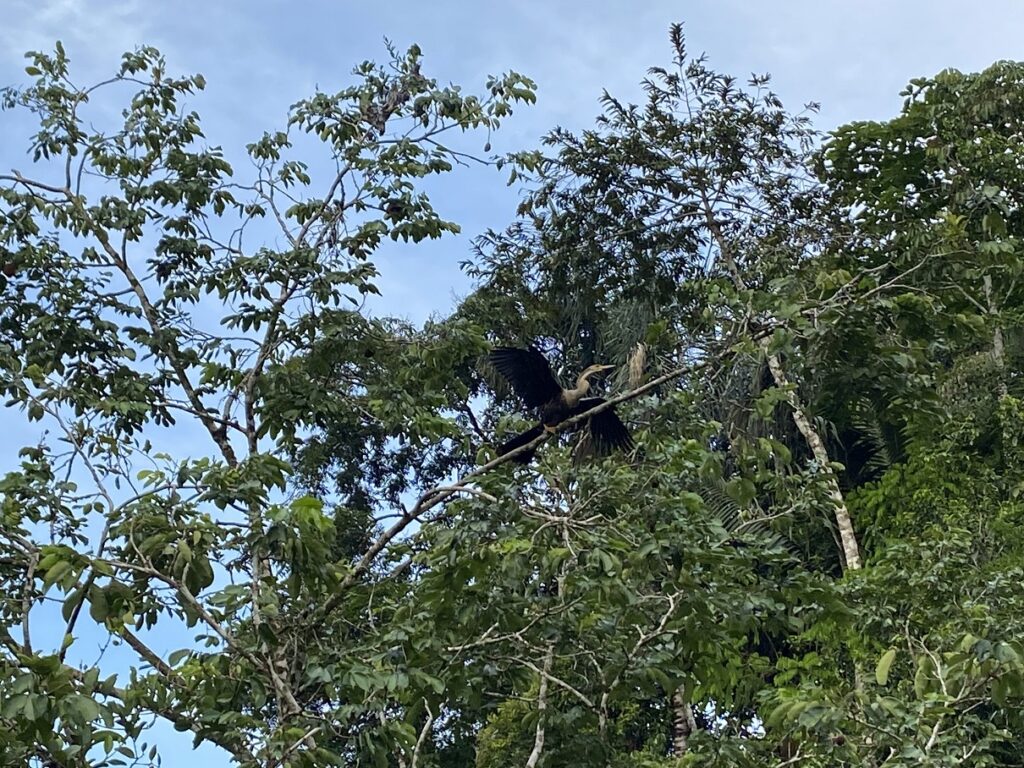
Day 2
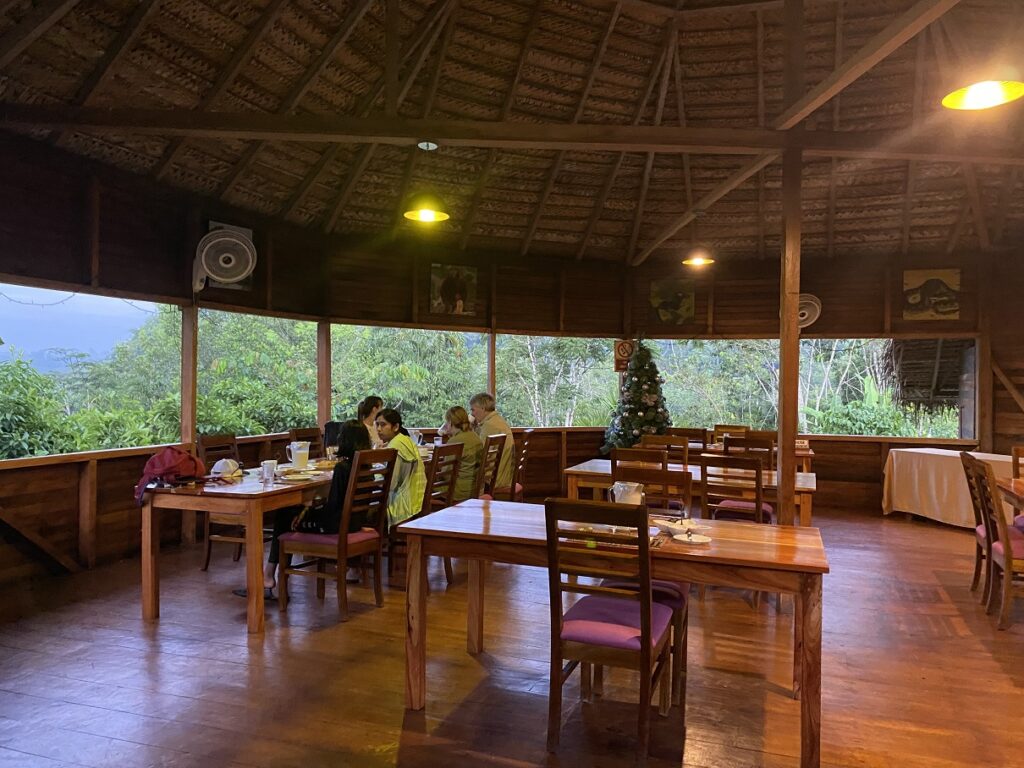
The next day, we got up early, around 5 am, and after breakfast, we were on the canoe by 6:15 am. Raul, always on alert, pointed out Macaws and other birds as we made our way across the lagoon into the flooded forest. The howler monkeys were probably the loudest of all the animals early in the day.
Canopy Tower – Kapok Tree
After 30 minutes, we got off the canoe and hiked for 10 minutes to arrive at a huge Kapok tree. We then climbed the 36m tower to a canopy built around the Kapok tree.
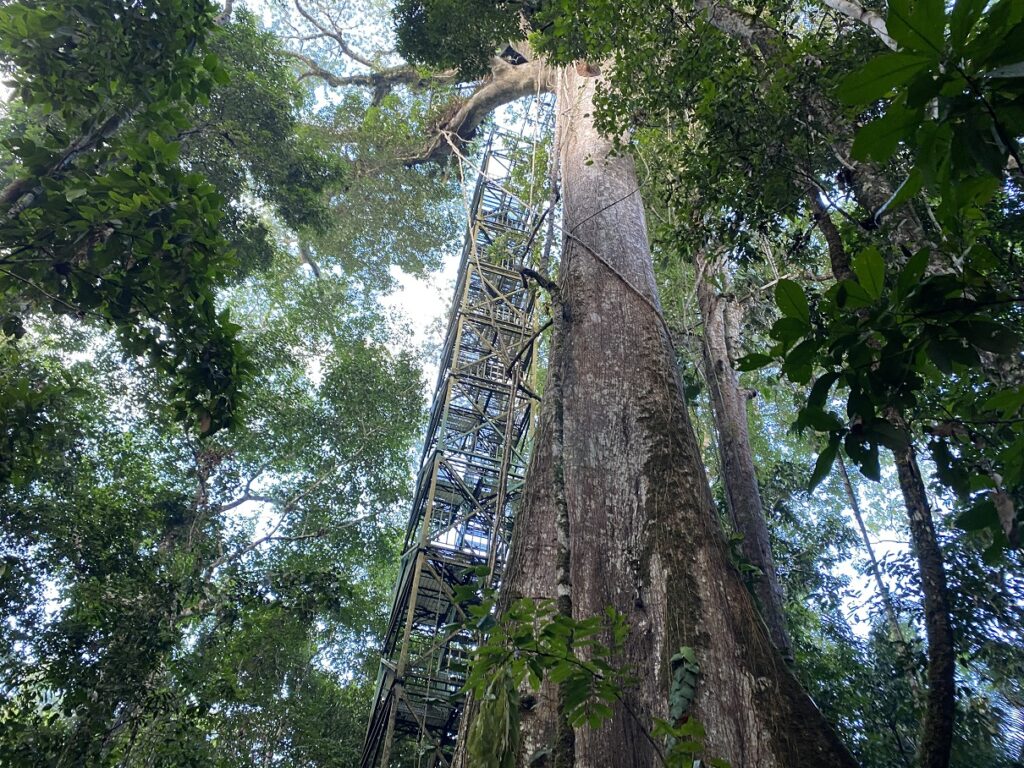
It had taken a lot of scouting and climbing different Kapok trees in the region to find one that would be suitable for a tower and a canopy. From the canopy, we had a fantastic view of the forest. Here is a great video from Sani Lodge that does some justice to the beauty of this place.
Raul and his assistant guide had even brought the spotting scope, and we put it to good use. Raul would scan the forest, hear something, and then use the scope to locate a bird or a sloth. Nothing excited Raul more than finding a Toucan. It’s a beautiful colourful bird with a very long beak.
A Great Potoo, an owl-like bird, had perfectly blended in on one of the branches of the tree. We also saw Kingfisher, Honeycreeper and other birds right around the tower.
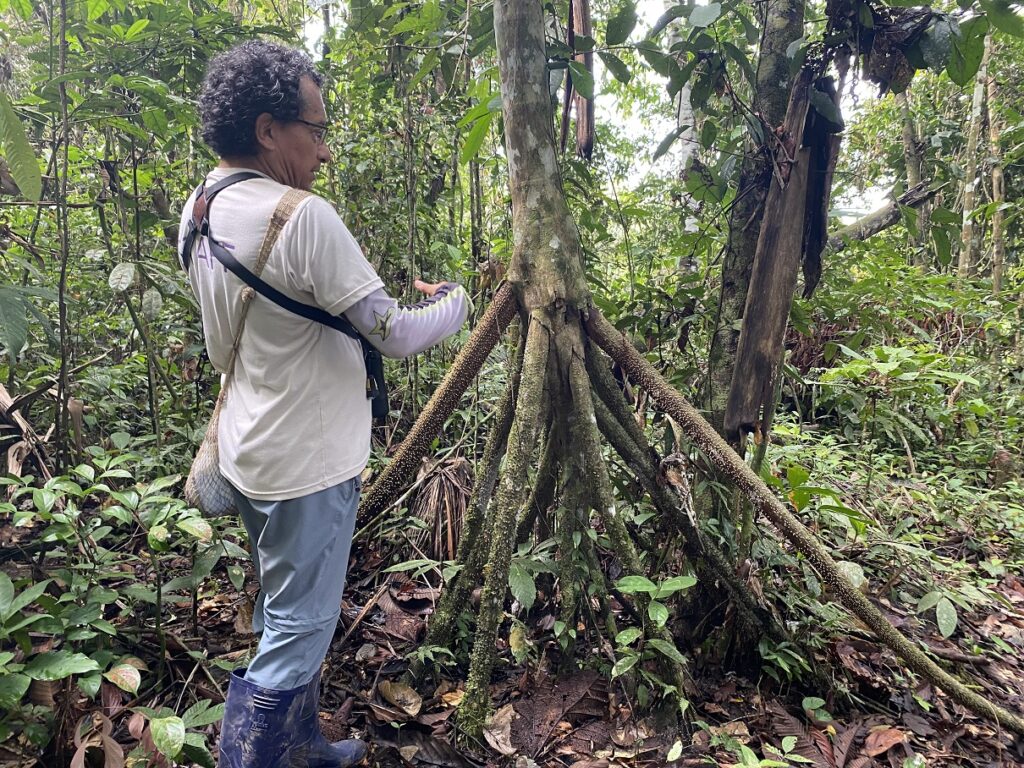
Piranha Fishing
After more than an hour, we came down from the tower and hiked back to the canoe. We came to a spot for Piranha fishing. Hugo took out several fishing lines and passed them around along with some bait meat.
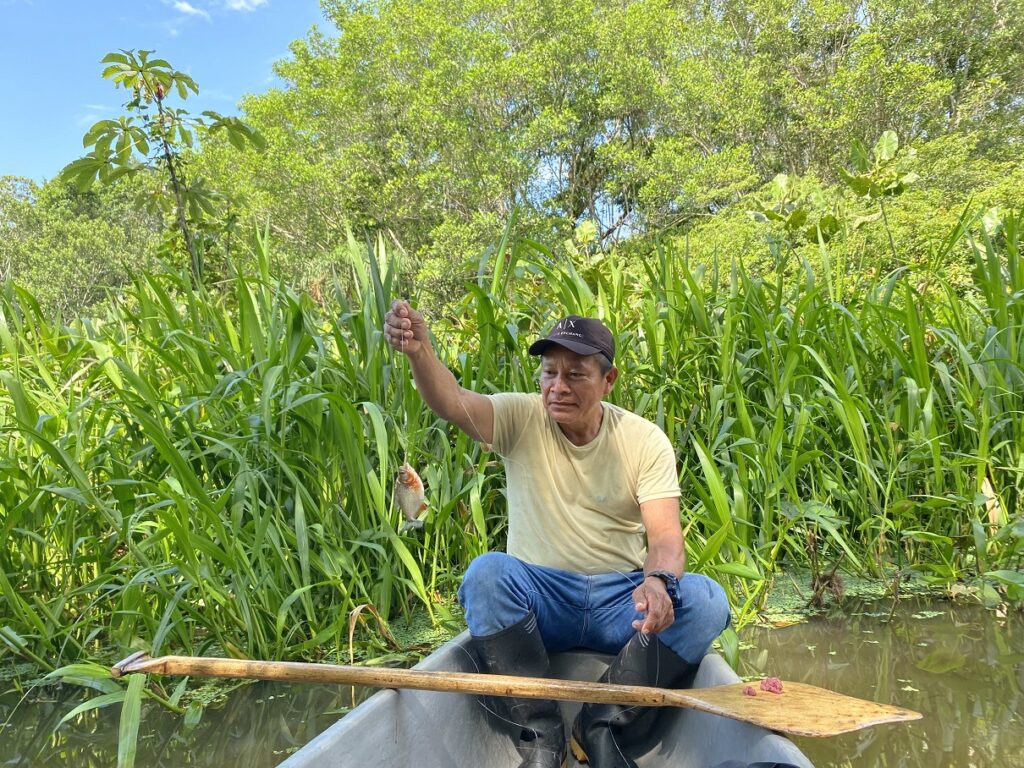
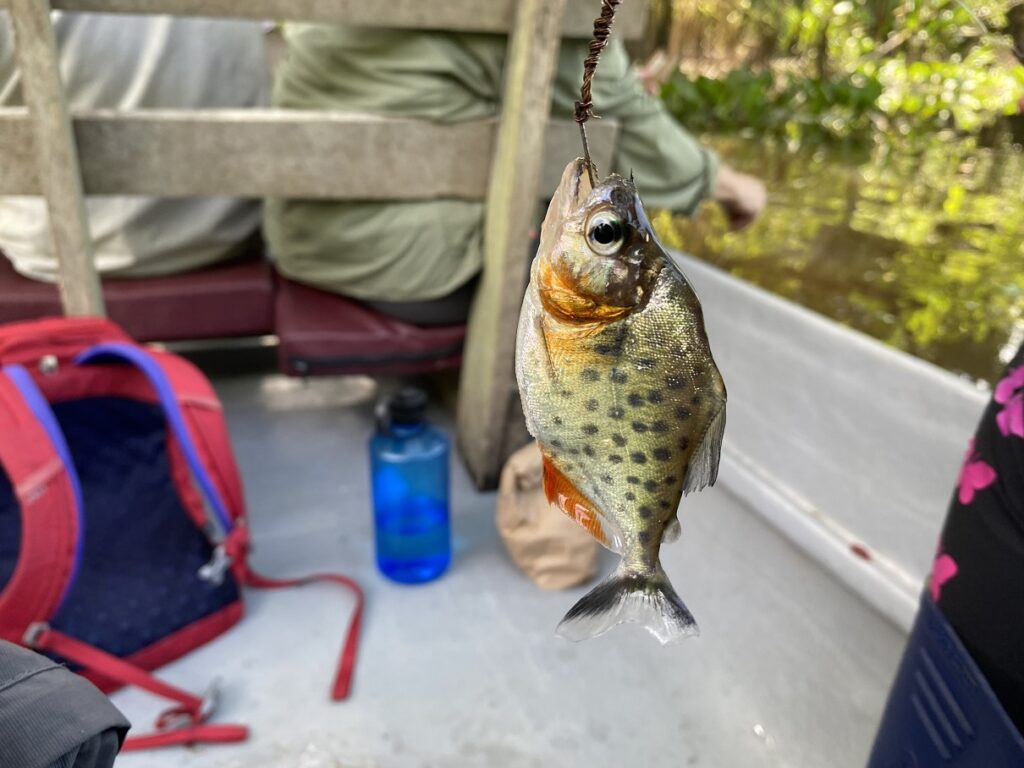
After Hugo’s demonstration, we all tried our luck. One of the tourists from the group knew what he was doing and was probably the first to catch a Piranha. After taking a picture, he soon released it back into the water.
I wasted more meat as bait than the elusive Piranha I was hoping to catch. Kavya was the first one in our family to catch one, and eventually, I got one as well. After an hour of feeding, catching and releasing the Piranhas, we were back at the lodge for lunch.
Hikes around the Lodge
Around 3:30 pm, we went out for a hike with Raul and Hugo. It was an easy couple of km walk around Sani Lodge, and we were back in an hour. Hugo demonstrated how to weave the leaves of a palm tree to create a shelter.
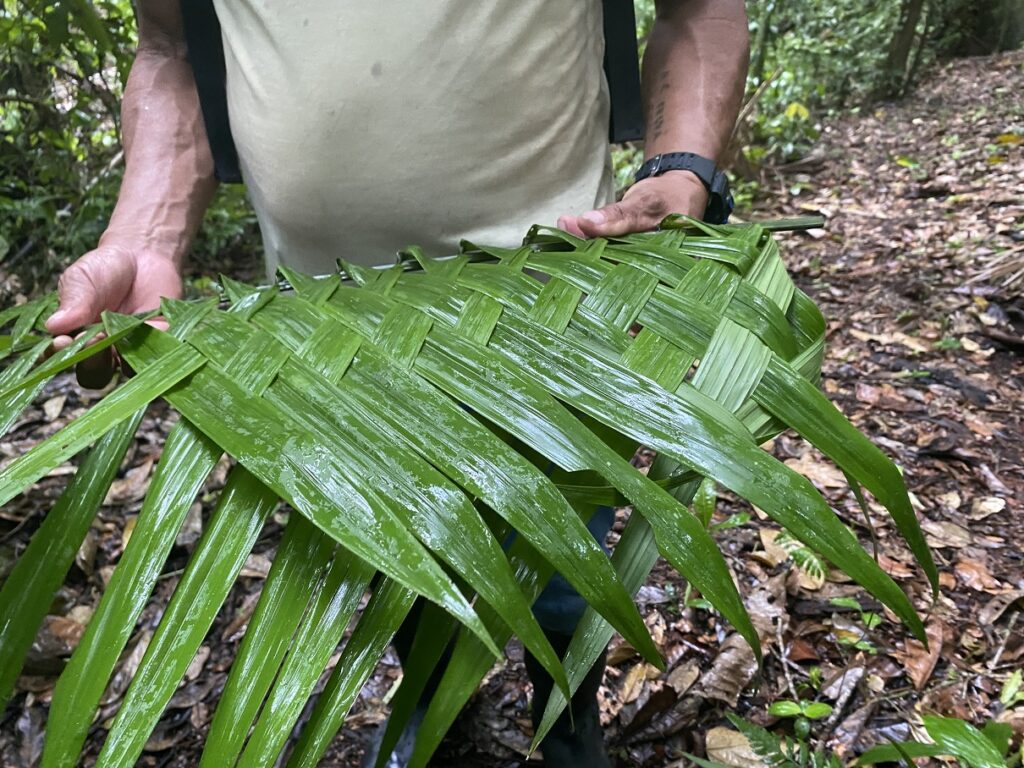
Later in the evening, I sent my mom the above photo as I had seen thatched roofs with similar patterns in Karnataka. She was excited to see the photo and said she used to weave coconut leaves as a kid to create a thatch (called Madalu in Tulu).
We had another walk after dinner, and this time, the lizards, frogs, and spiders were in the spotlight.
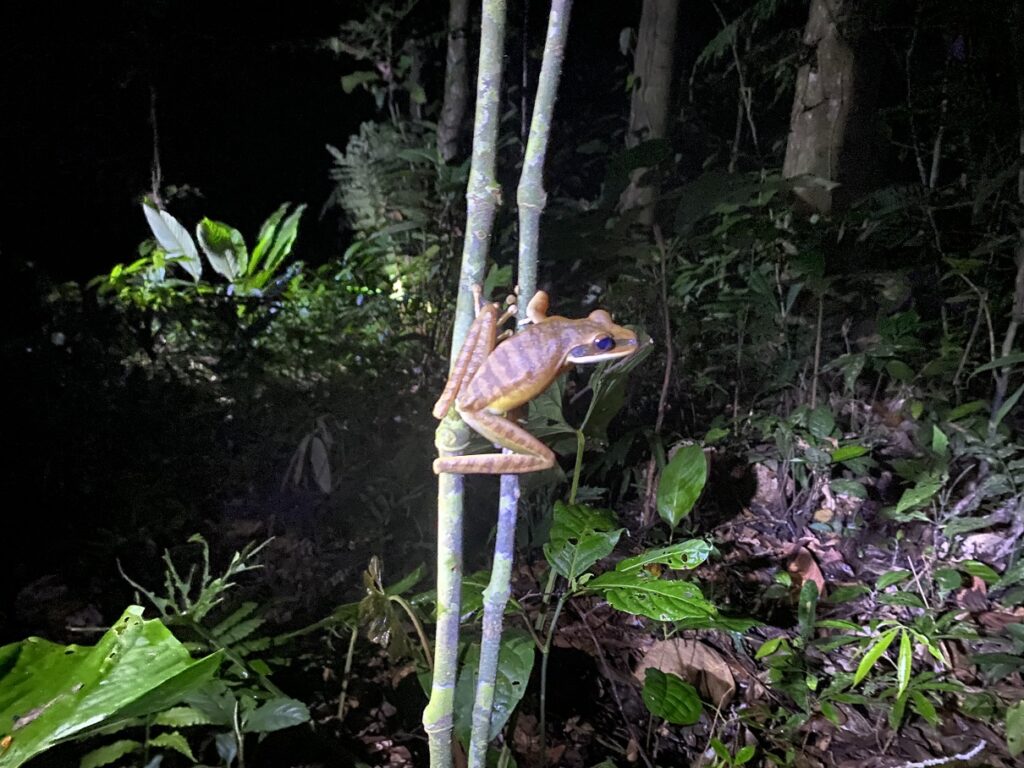
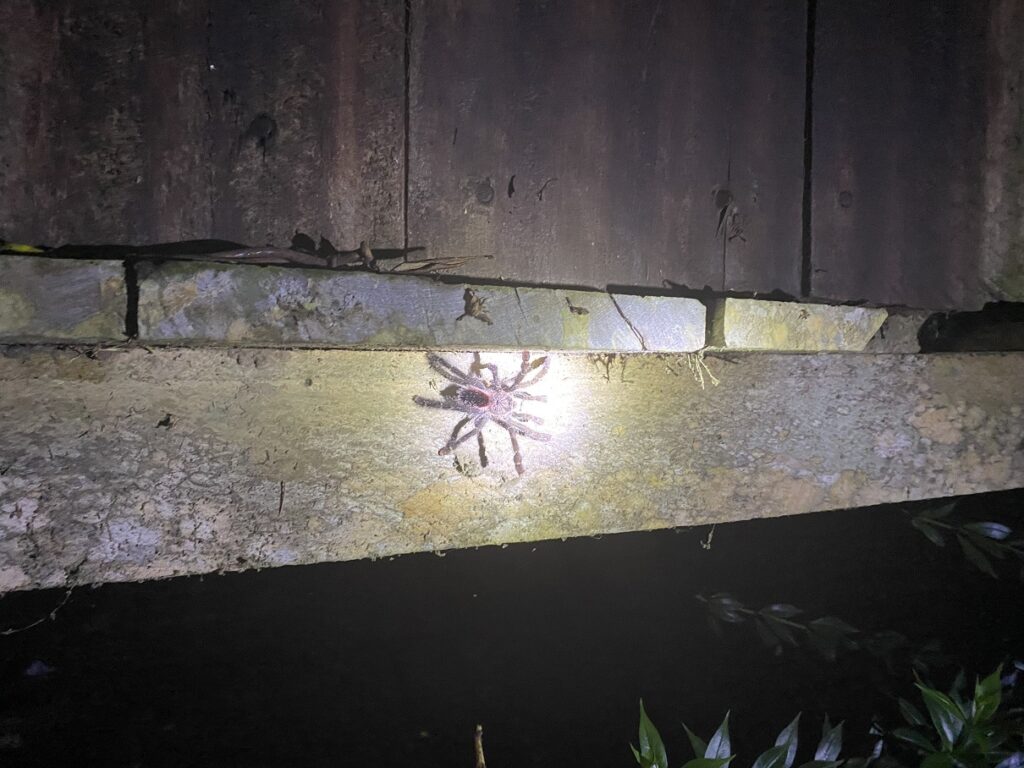
Day 3
The next day, we were back in the canoe at 6 am. Today, we will be visiting the Parrot Clay Lick and the Sani Isla Community Center.
Parrot Clay Lick
The water level was down in the flooded forest, so we couldn’t canoe out to the Napo River. So, after a short ride in the paddled canoe, we got down and hiked across the forest to the river bank.
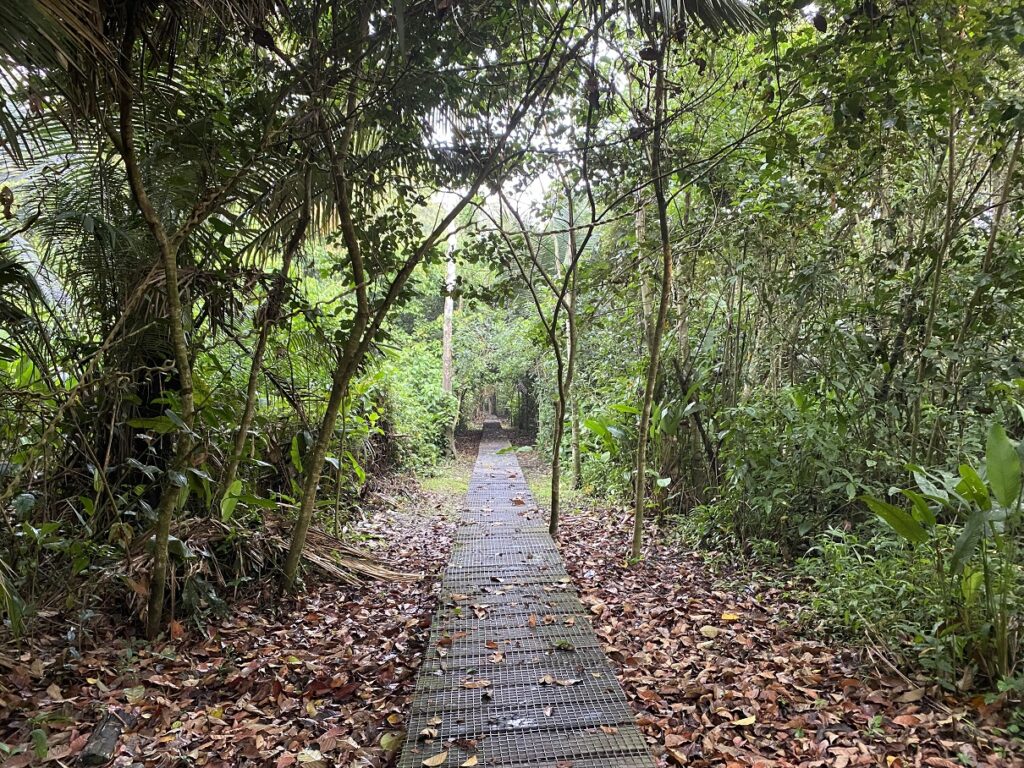
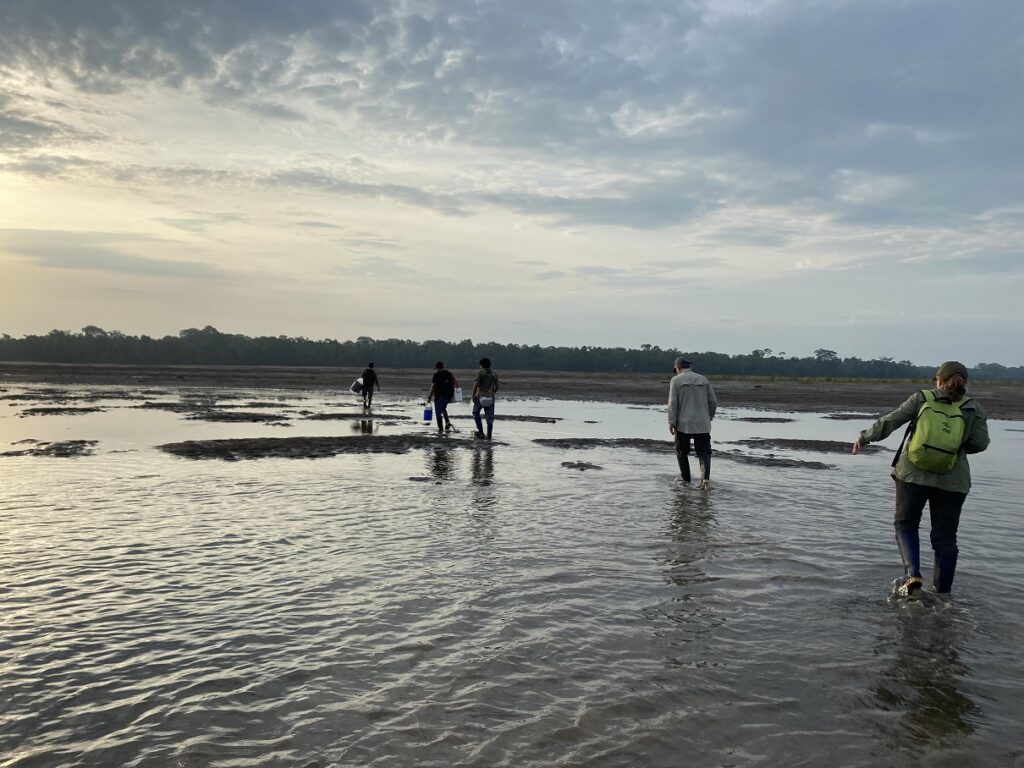
Once we got to the river bank, we got on the bigger motored canoe. It was a short 20-minute ride to the Parrot Clay Lick along the Napo River.
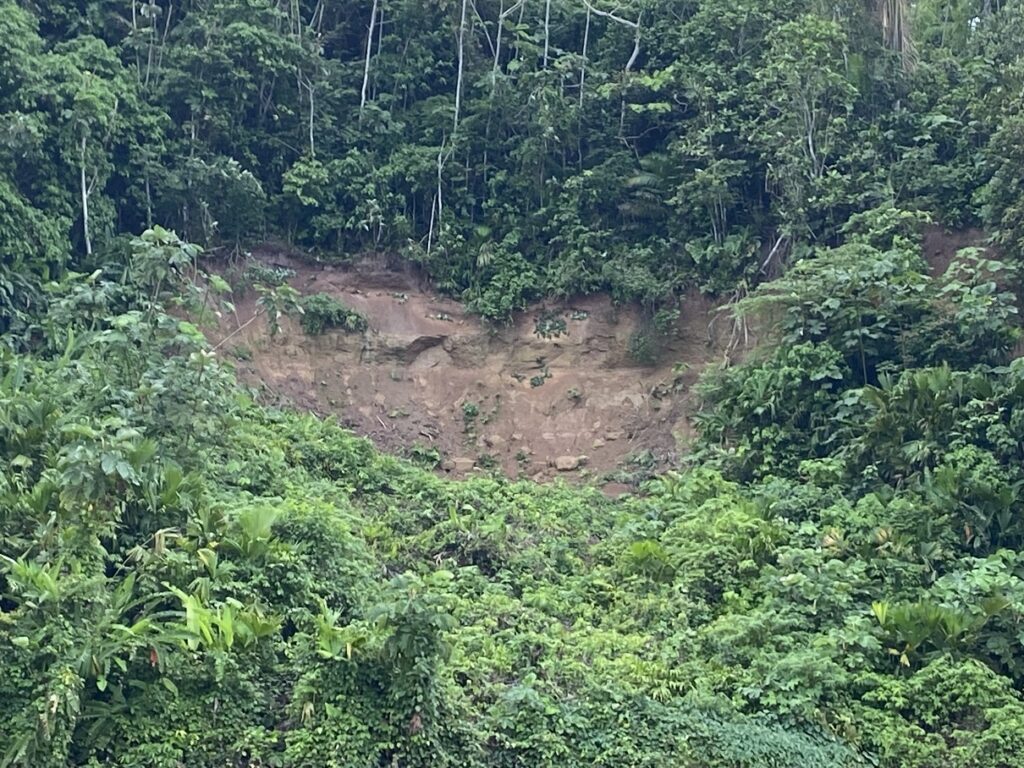
The clay lick is a landslide that exposed the clay, which apparently is a great source of nutrition for parrots and parakeets. There were hundreds of birds and different species of parrots – Mealy-Amazon, Blue-Headed, etc. as well as parakeets.
After 10-15 minutes, a big vulture spooked the birds, and they flew off. We were lucky that the vulture didn’t arrive there before us.
Yasuni National Park Hike
From the clay lick it was a short ride to the Ranger’s office at Yasuni National Park. After a quick break at the shelter, we started our hike.
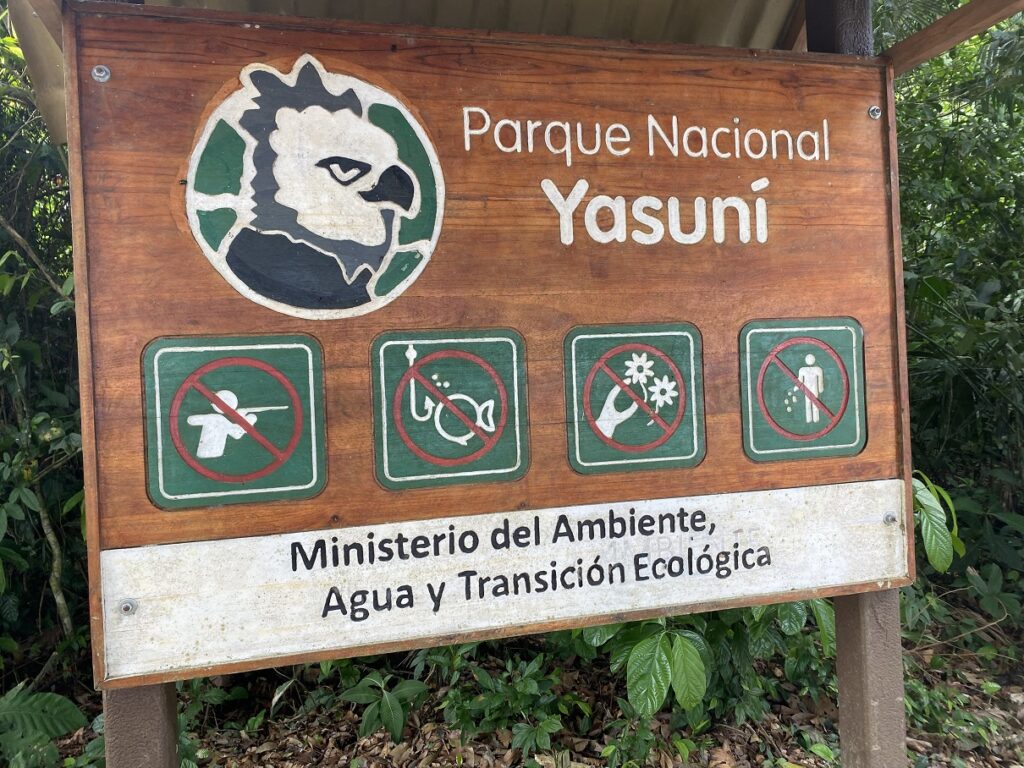
This was a different forest and ecosystem compared to the flooded forest we had hiked earlier.
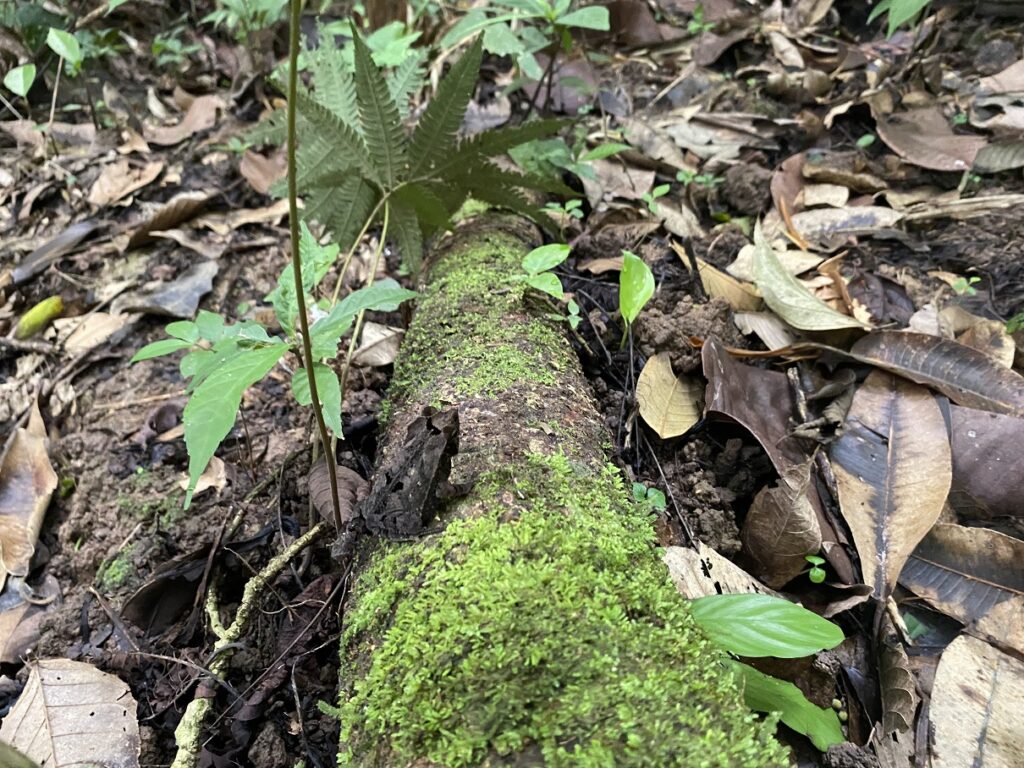
Hugo would walk ahead, spot birds and animals or look out for an interesting plant. Then he would share something with Raul in Spanish and then Raul would translate it to us in English.
Hugo grew up hunting in these forests and you can sense the deep connection he had with the forest. Through Raul, he shared stories of hunting as well as the history of different tribes in the region – some that are still in the uncontacted peoples category. There are two such tribes in Ecuador, both in the Yasuni National Park.
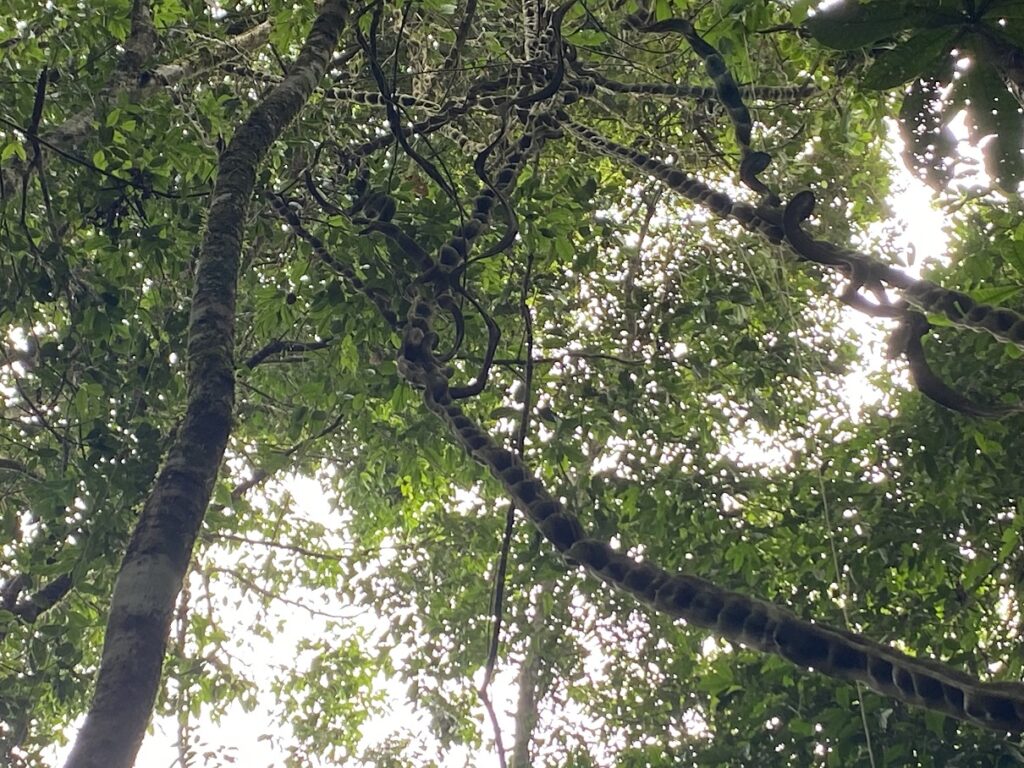
Raul, as a naturalist guide, was great in explaining the ecosystem and how everything was connected and dependent on each other. Although Raul shared stories of spotting Jaguars in this forest, we were not that lucky. We were content with the huge tortoise that Hugo spotted towards the end of our hike.
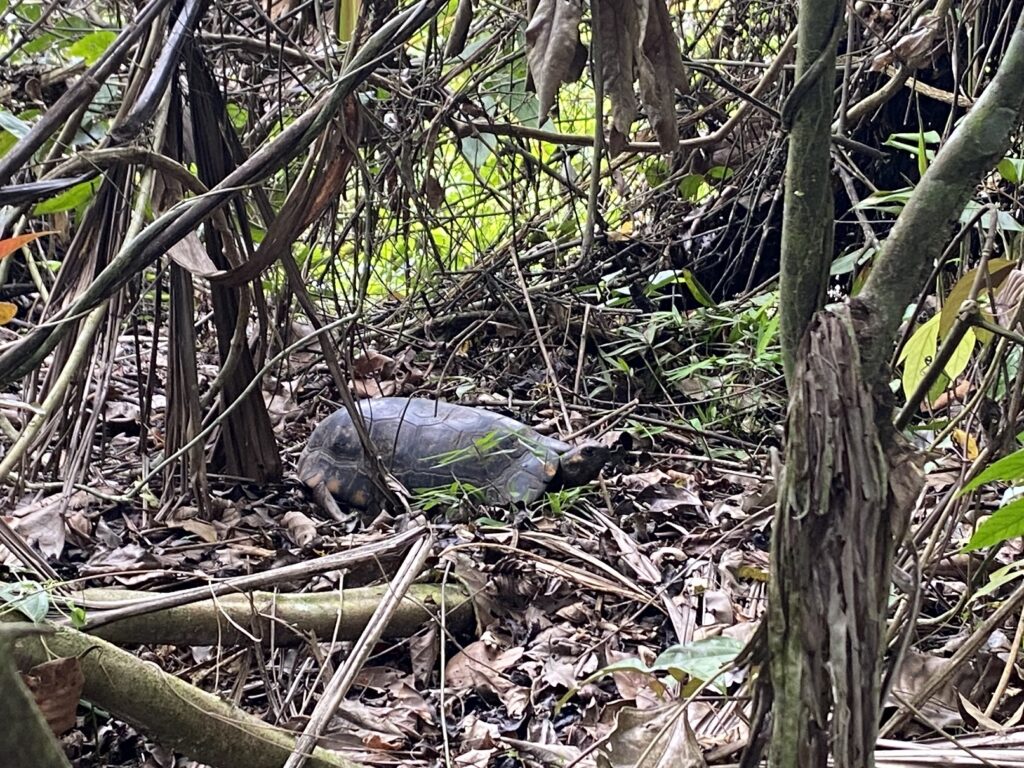
Once we returned to the Ranger’s office, we ate our packed lunch in the shelter and then got back in the canoe. Next stop – Sani Isla Community Centre.
Sani Isla Community Centre
It was another 20 to 30-minute ride in the motored canoe to the community centre. We first stopped by the school.

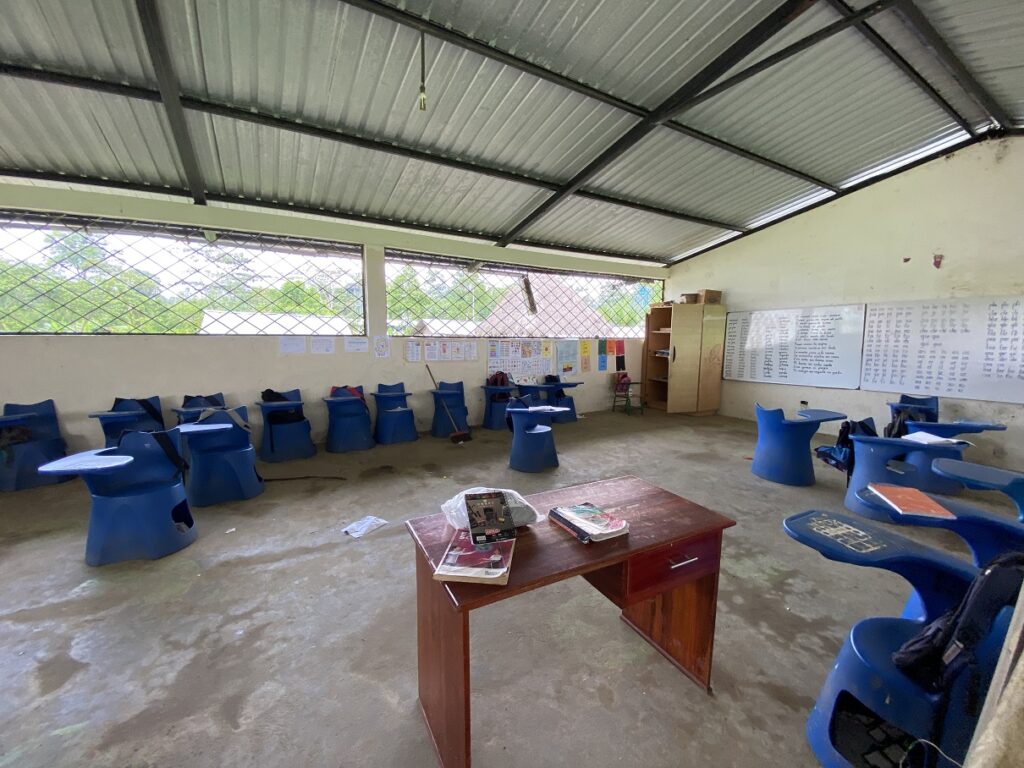
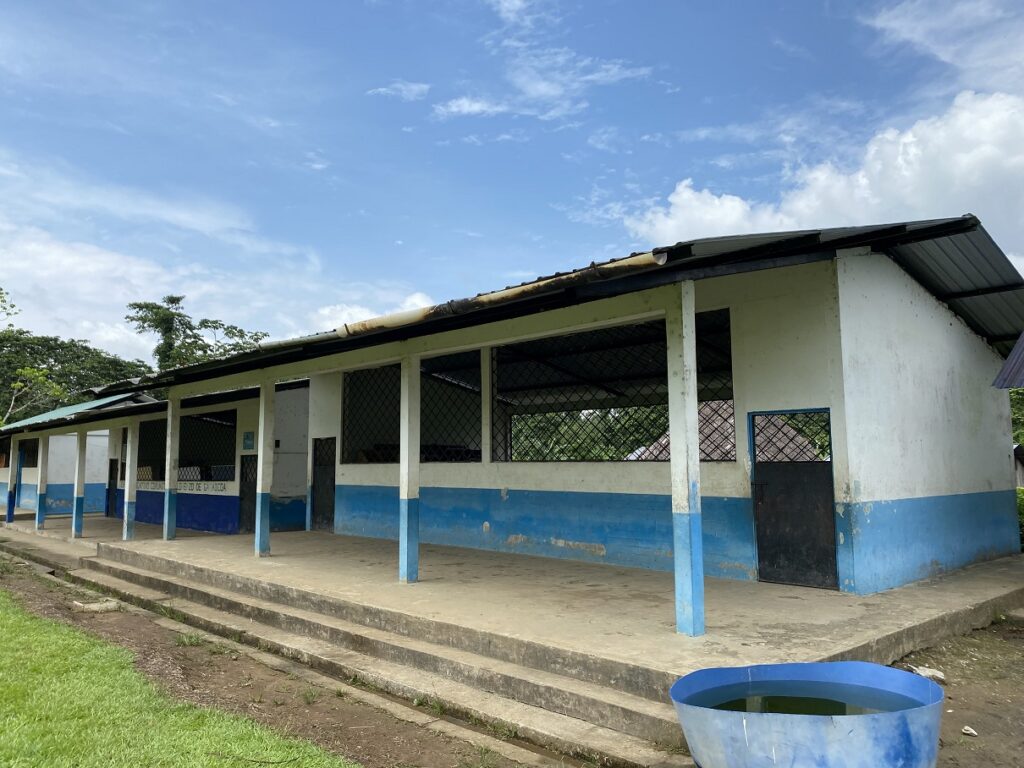
Then, we met the women of the Sani Warmi organization. It employs women through the sale of handicrafts and tourism and also manages the freshwater turtle reinsertion project.
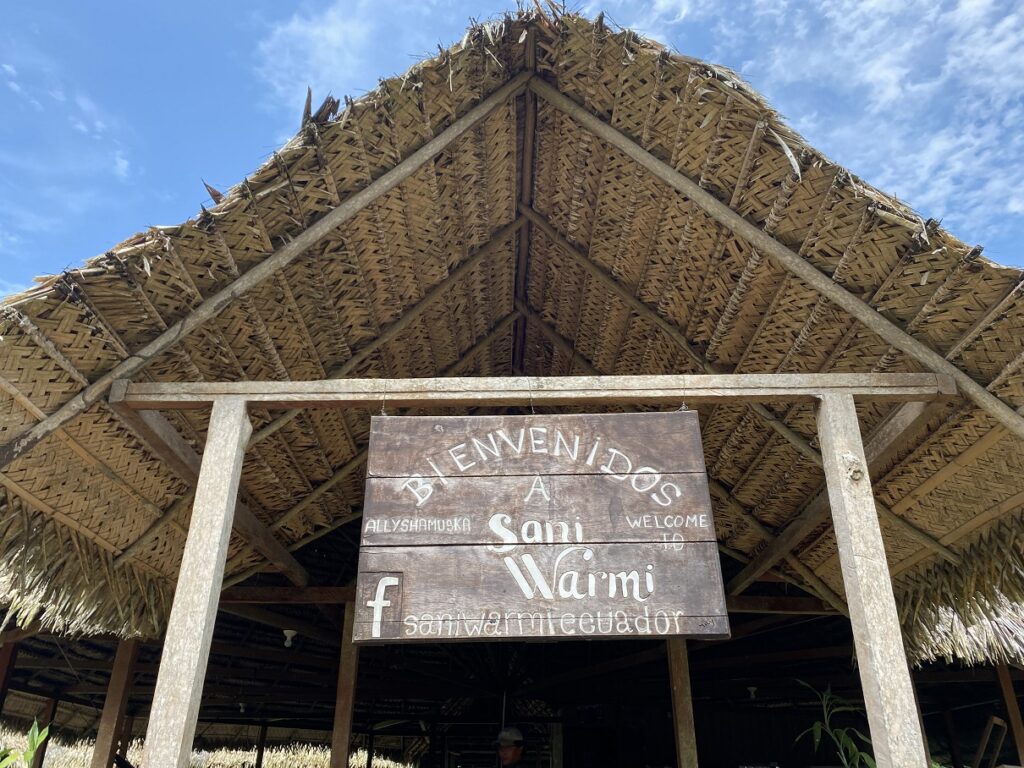
Cooking Class
After a welcome and introduction, we sat down in the community kitchen for a cooking class with a cup of guayusa tea. After a demonstration, we took turns in preparing our meal. We would first arrange palm leaves on the table, add a mix of the core of the palm tree, fish (optional), lemon and salt, tie the leaves and then smoke it on the grill.
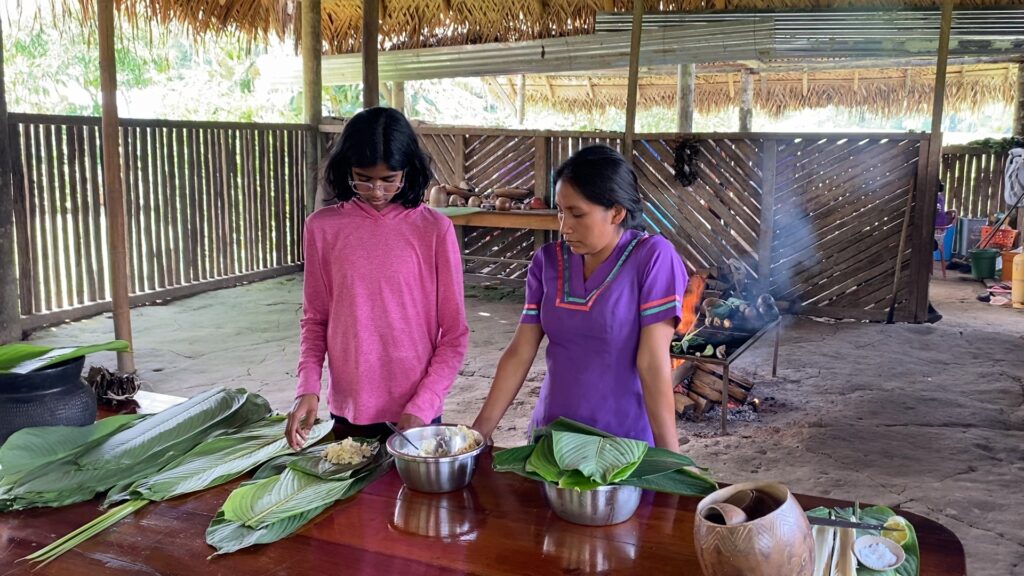
While our lunch was being prepared, Hugo kept us busy with a blowgun and darts. He mounted a banana blossom on a pike as our target. Side note – I used to get the banana blossom (Poombe in Tulu) from a farm behind our house in Ahmednagar, and mom would make chutney or a curry with it. Now, I was “hunting” it in the Amazon.
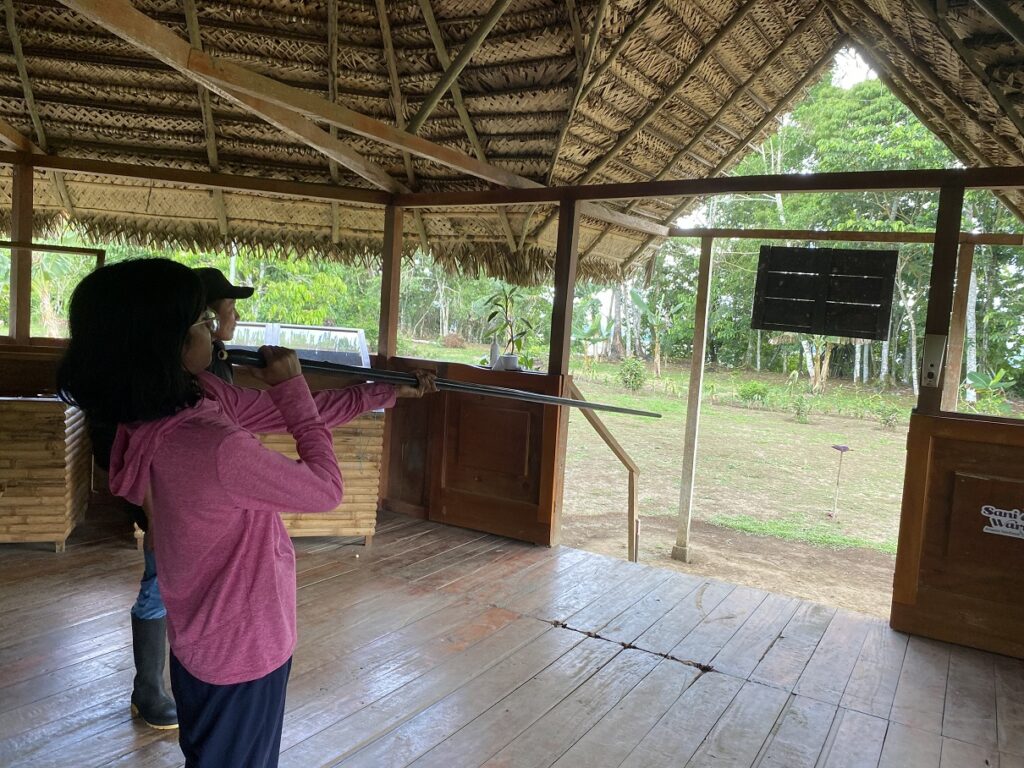
The wooden blowgun was long and heavy, and it took some time to balance it and blow the dart. After multiple attempts, I got one of the darts on the banana blossom that was barely 20 feet apart. If I had to hunt and survive on this, my days in the jungle would be limited. Thank god I am vegetarian. I would die of eating poisonous plants and not of hunger.
Just as we were wrapping up our target practice, we saw a woman with a pygmy monkey on her shoulder. Pygmy monkey is the world’s smallest monkey and can fit in your palm. It was her pet. After about half an hour, our lunch was ready. We went back to the communal kitchen and enjoyed the meal with some chicha.
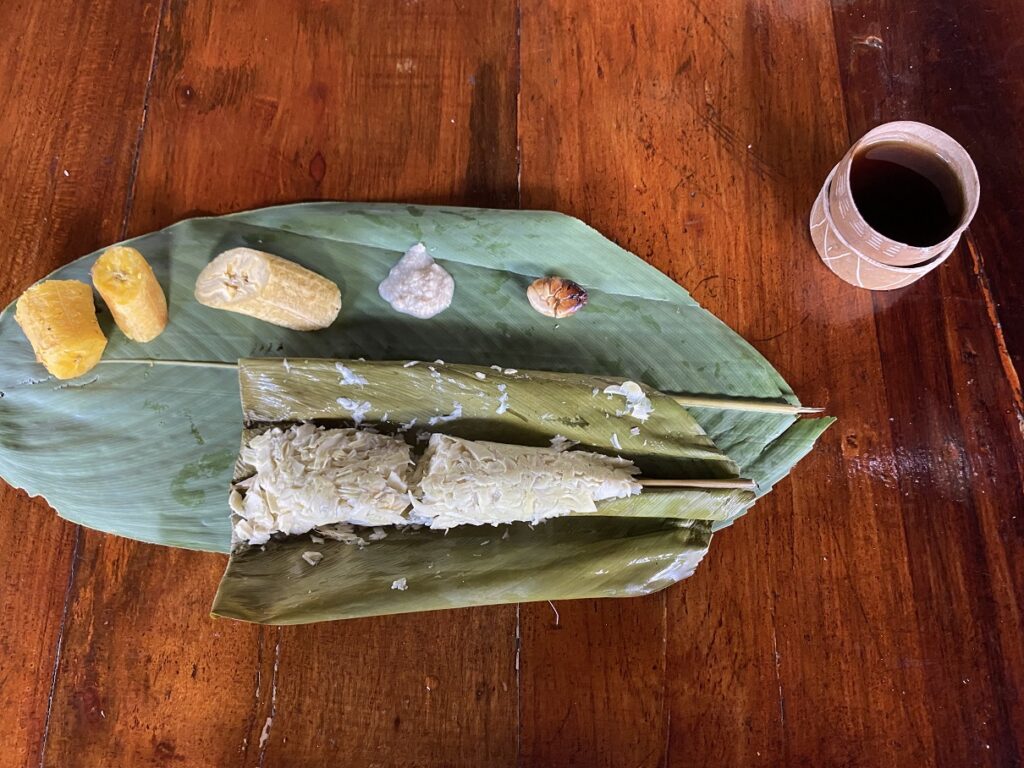
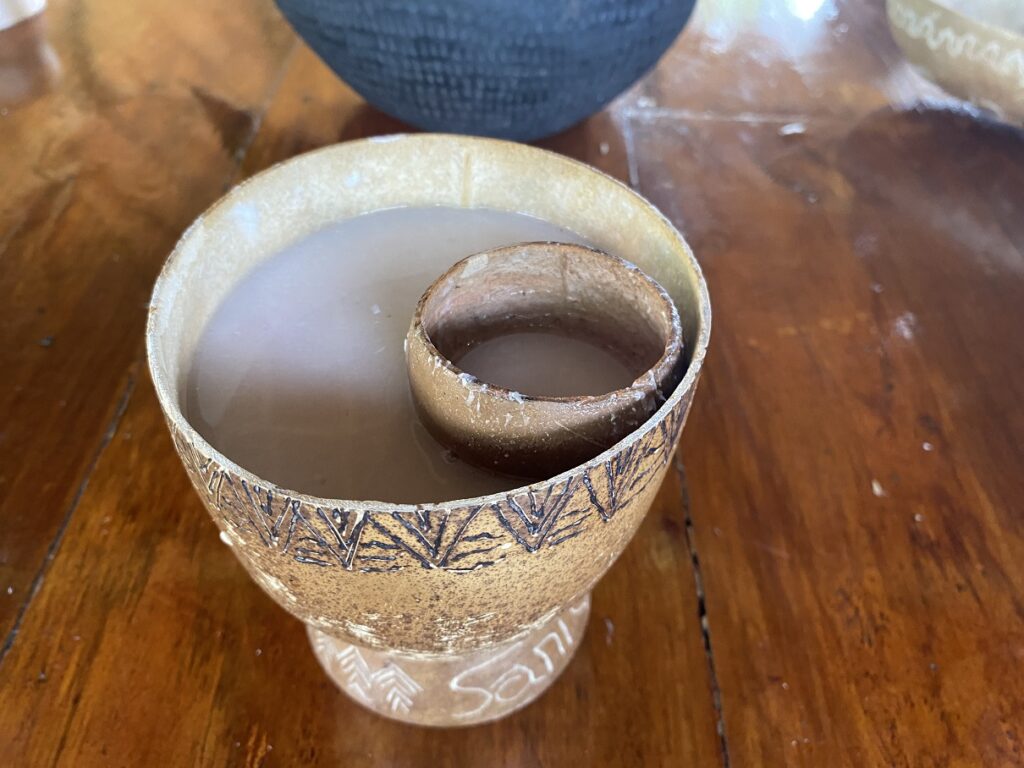
Worms
We were also offered to eat live worms. When we hesitated, a toddler happily gulped down a couple of these worms. The staff offered to cook some of these worms over the fire. To my surprise, Kavya ate one of these cooked worms.
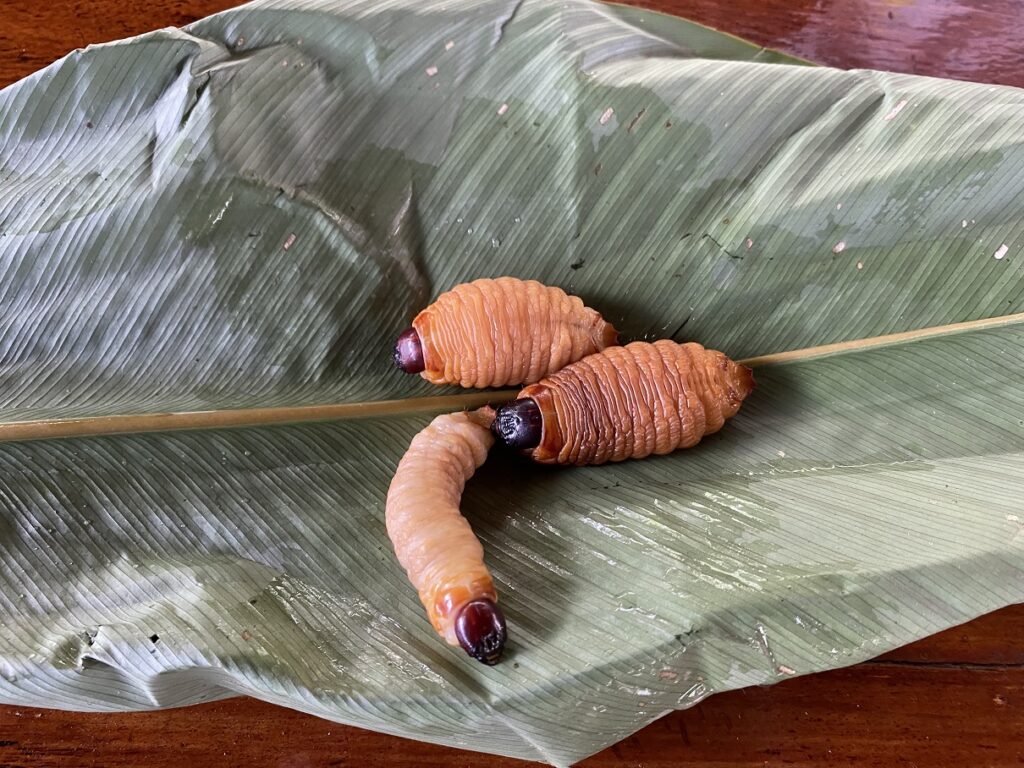
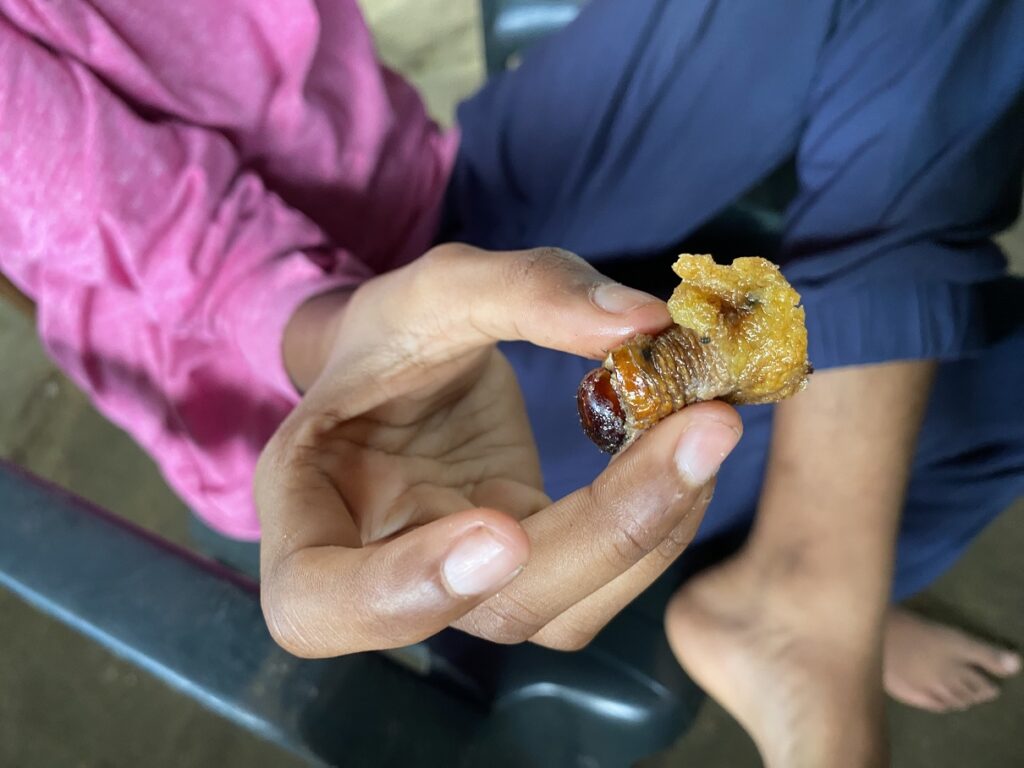
Late in the afternoon, we returned to the lodge and, on our way back, attempted to paddle through the flooded forest. As expected, it was harder than what the locals made it look.
Day 4
The next day, we took it easy and skipped the planned canoe ride and hike. Instead, we had a late start and asked Alex if he could guide us on a short canoe trip around Challuacocha Lake.
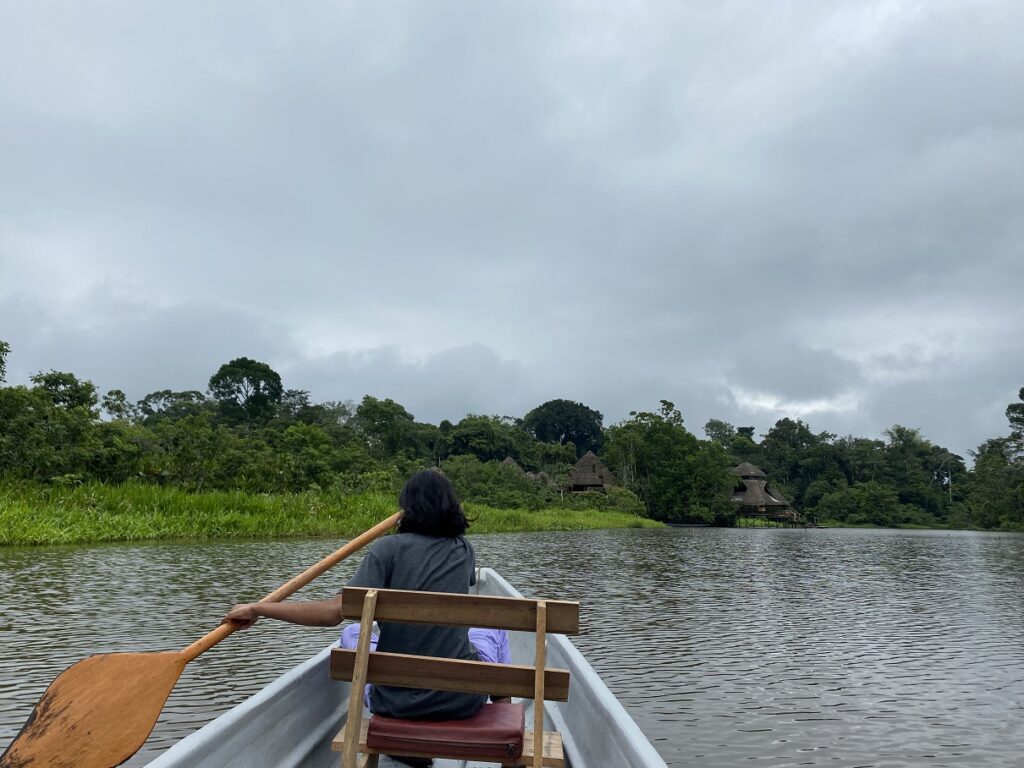
Around 9:30 am, Kavya, Kasturi and I, along with Alex, set out on our private canoe trip. Kavya was at the front with a paddle while Alex steered the canoe. We all took turns paddling, but in reality, Alex did most of the work. He was also great at spotting birds and sharing information – a budding naturalist guide.
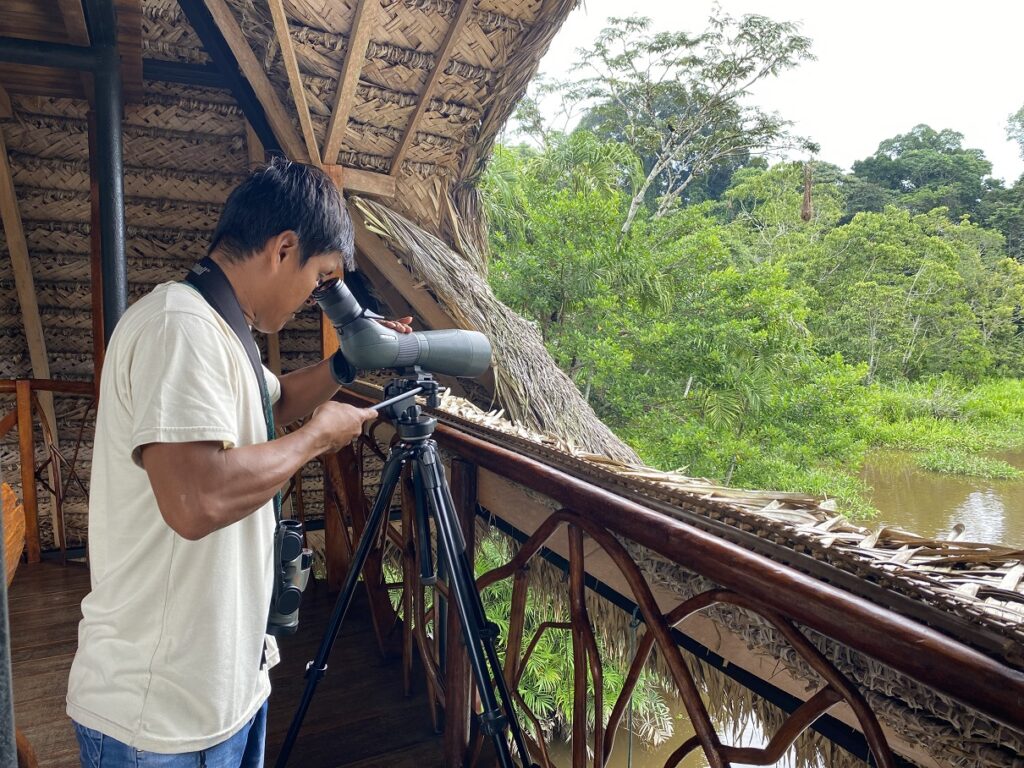
After we got back to the lodge, Alex and I continued looking for birds from the upper levels of the docking area. Alex brought the spotting scope and showed me how to use it. He was very excited to see the Least Bittern as Raul had mentioned that it is not easy to spot this bird. But we got lucky and it stayed in a place long enough for Alex to get some pictures through the scope.
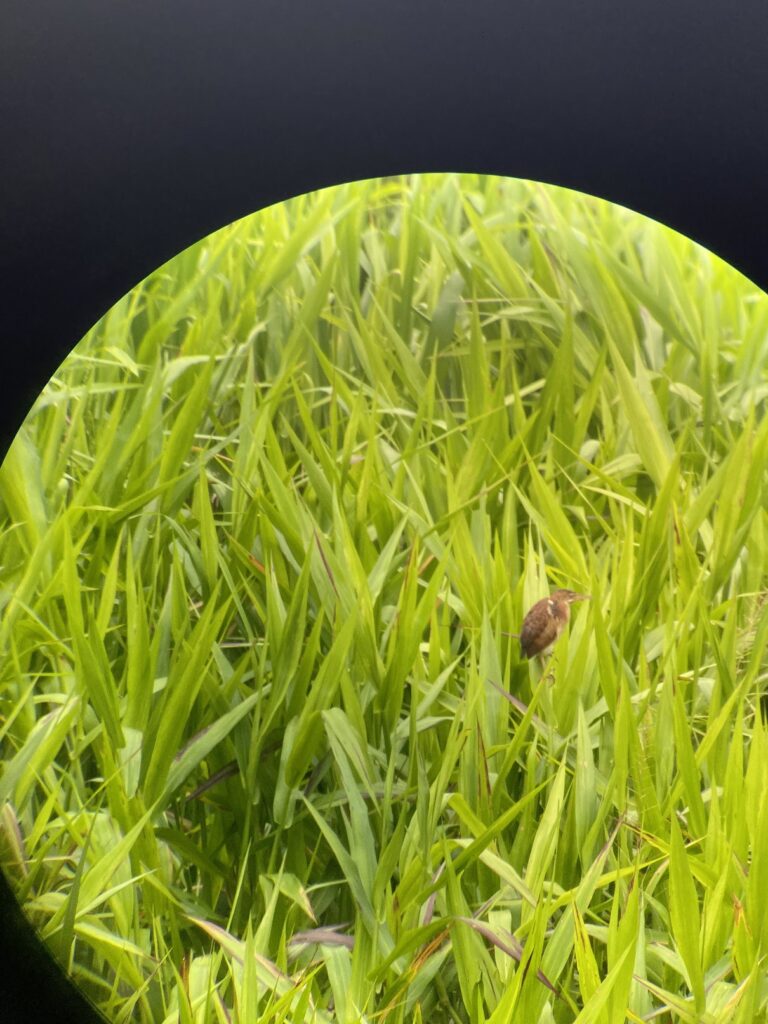
Another staff member was really good at placing the phone camera close to the scope and adjusting it, to take some great shots.
Later in the evening, we had our final outing with Raul and Hugo. All of us had our eyes peeled to spot an anaconda as we canoed through the dense flooded forest, but no luck. It was still an enjoyable canoe ride spotting some familiar birds.
Day 5
On the last day, we had an early start and left the lodge by 5:30 am and reached Coca in time to catch our 10:30 am flight to Coca.
It was my first trip to the Amazon, and the Ecuadorian Amazon lived up to its reputation for high biodiversity. During our five-day visit, with the help of Raul and Alex, I recorded 110 different species of birds and animals.
Sani Lodge staff were great and did a great job of making our stay comfortable and cooking vegetarian meals even in this remote part of the world.
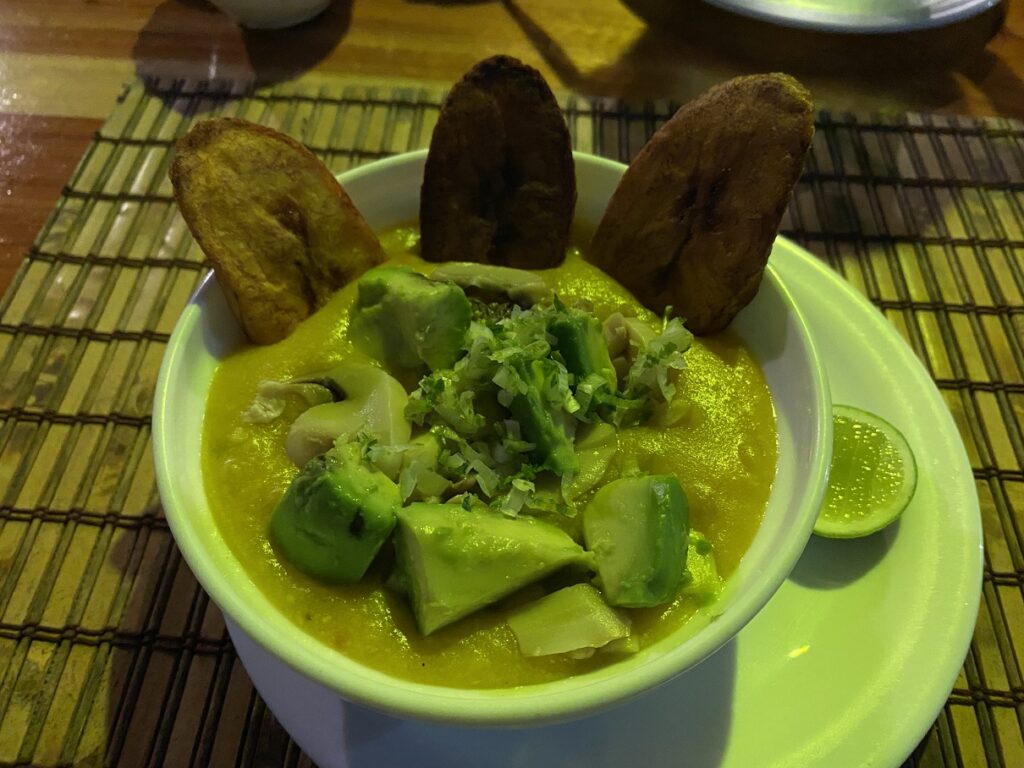
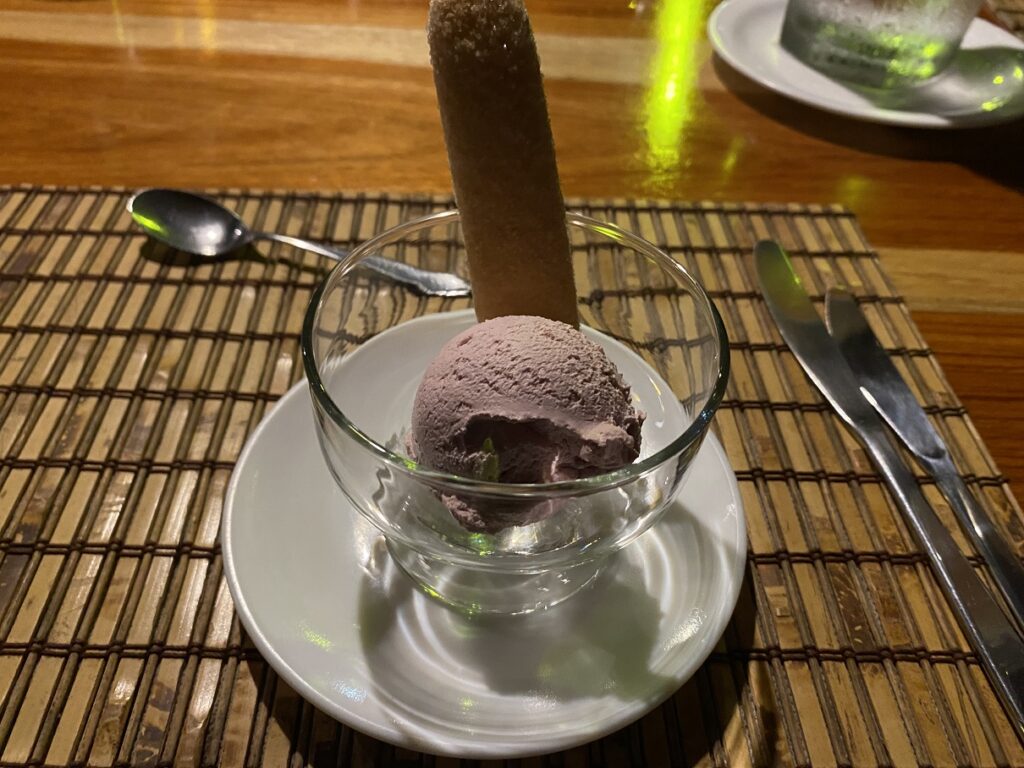
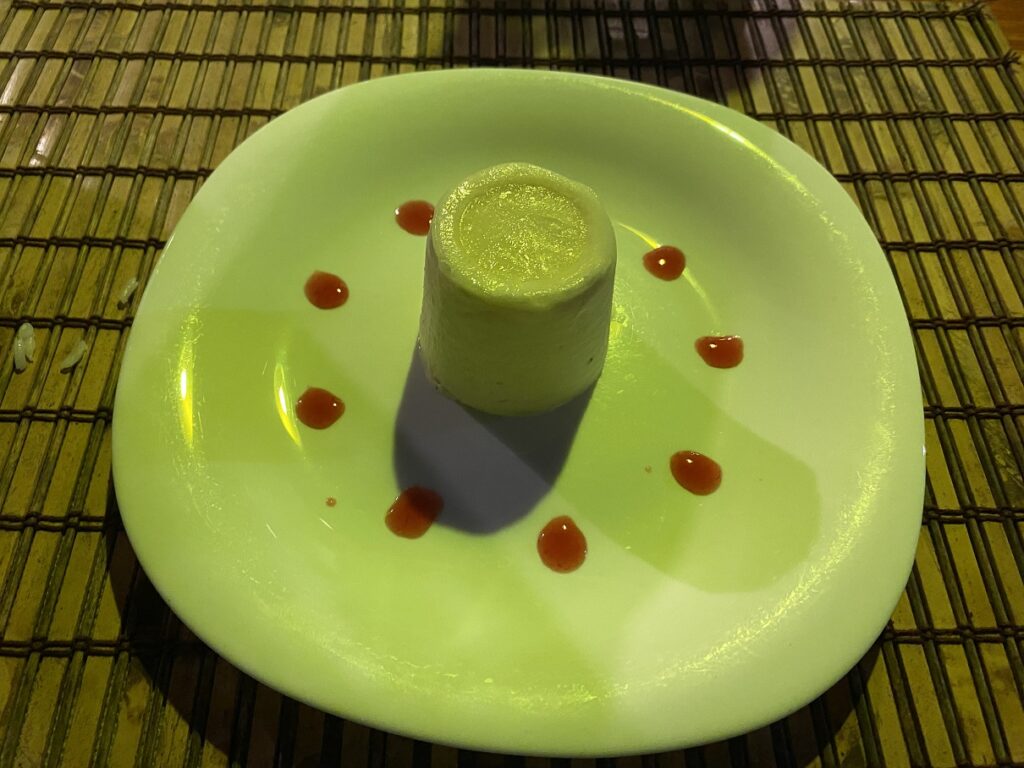
More power to projects like Sani Lodge that are leveraging tourism to empower the local Indigenous communities and protect this unique place.
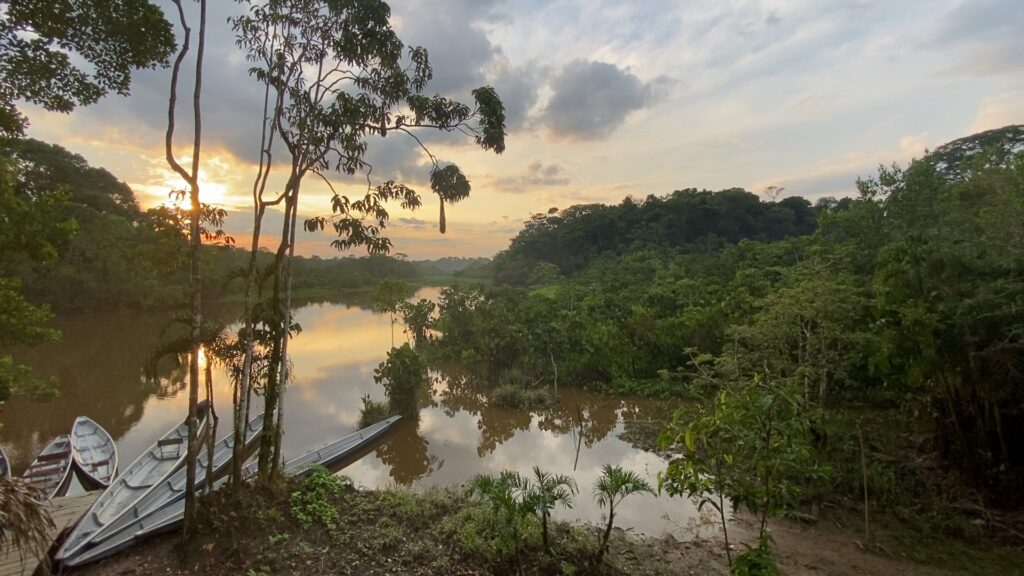
Our next leg of the trip was to another well protected and unique ecosystem – The Galapagos.
Resources:
Sani Lodge: 5-Day Experience | Sani Warmi – Community Womens Project
Ecuador Amazon Travel Guide: Happy Gringo
Disclosure: The links I have shared in the post and under the Resources section are not Affiliate Links.
Please subscribe to get regular updates.
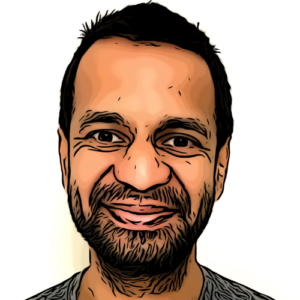

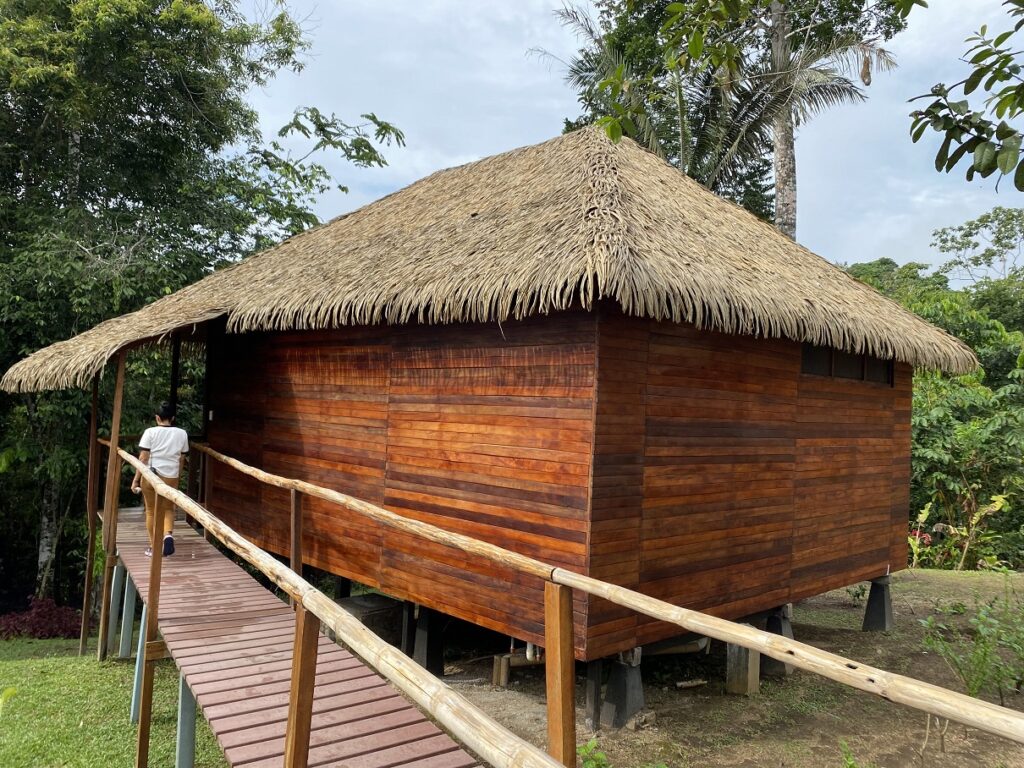

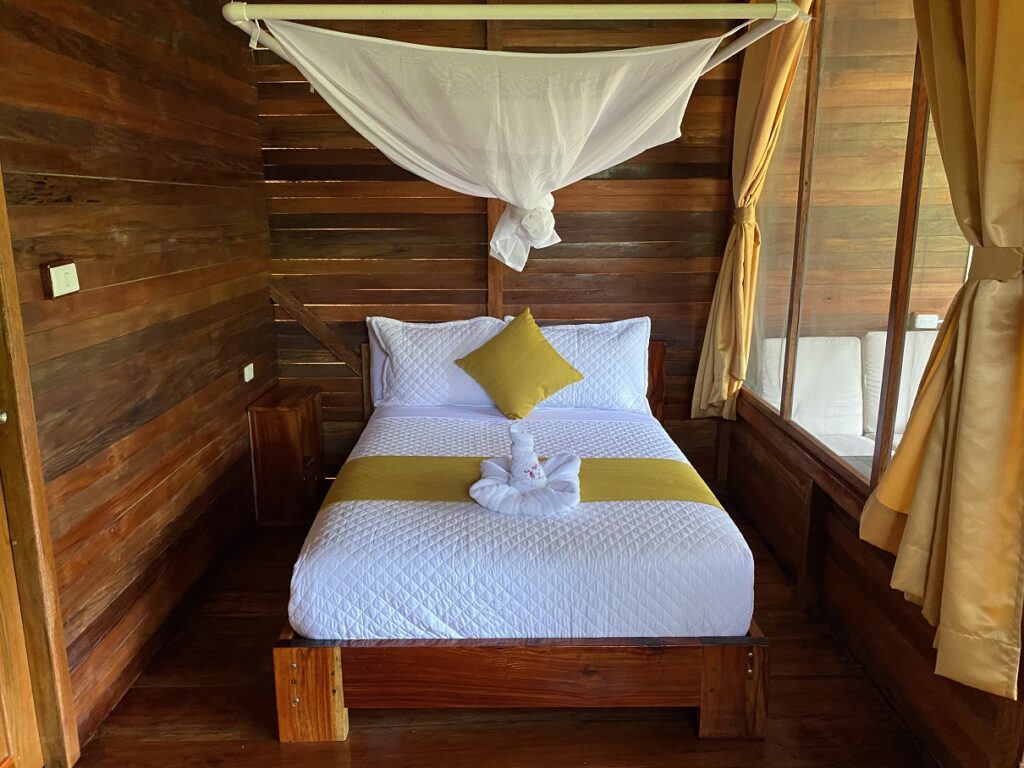

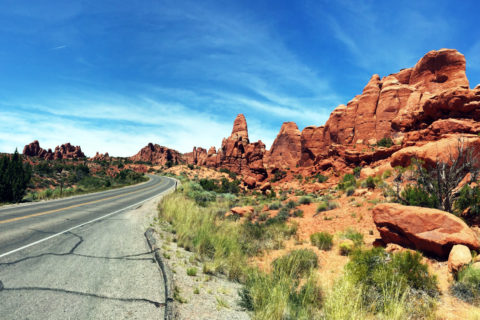
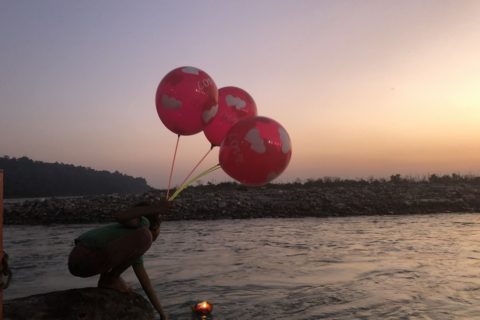
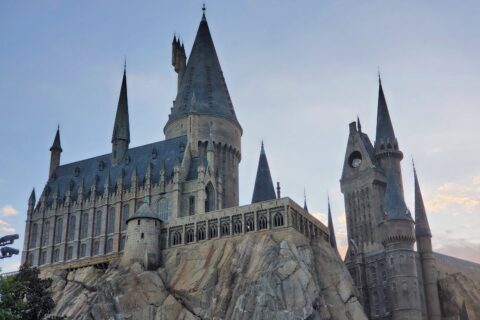
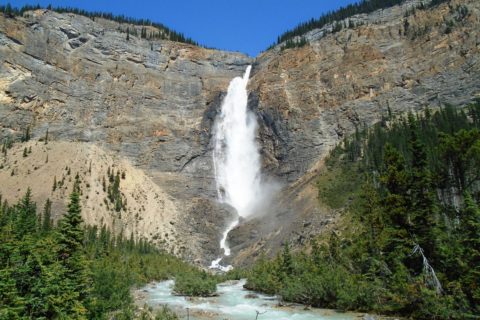

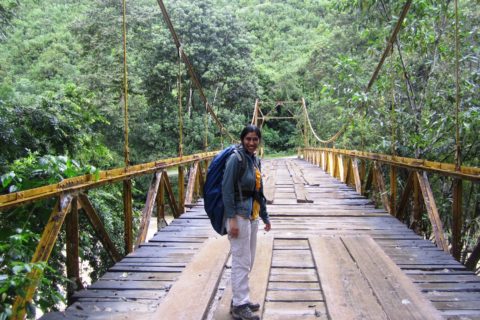
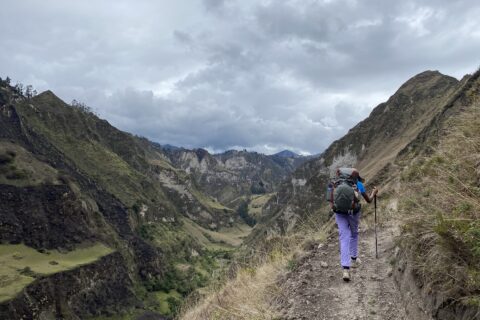
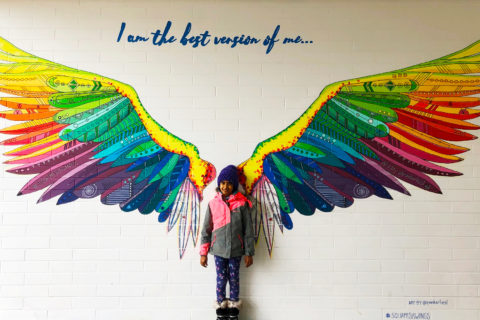
v.good Raja
well explained
I like it
छानच लिहिले आहे. सनी लॉज मस्तच..आणि फोटोज पण
Very nicely described and written. As if we were there experiencing those scenics.